The Ryan Family Defense: How Buddy Ryan invented the 46

The following is a chapter from the bookBlood, Sweat & Chalk: The Ultimate Football Playbook: How the Great Coaches Built Today’s Game, published in 2010 by Sports Illustrated Books.
The scene was remarkable not just because it was poignant but also because it was so unusual. The 1985 Chicago Bears had just finished off a 46–10 deconstruction of the overmatched New England Patriots to win Super Bowl XX in the Louisiana Superdome, and the giddy celebrations had begun on the field. Chicago coach Mike Ditka, beloved by these Bears, was lifted onto the shoulders of some of his players—this came as no surprise. But then the strangest thing happened: Suddenly there was Bears defensive coordinator Buddy Ryan being hoisted by linebacker Otis Wilson and defensive end Richard Dent, Ryan’s right leg over Wilson’s left shoulder pad and his left leg on Dent’s right pad, both men laughing, while the rumpled old coach, stuffed into his Bears sweater, awkwardly tried to keep his balance. A defensive coordinator getting a victory ride?
Only once in the intervening years has a Super Bowl title been as convincingly built on defense (in 2000, by the Baltimore Ravens). But the ’85 Bears were more than their defense. They had become a pop cultural phenomenon, with a celebrity coach, Ditka; a celebrity quarterback, Jim McMahon; and a celebrity nosetackle turned tailback, William (the Refrigerator) Perry. They had released a kitschy, funky video—The Super Bowl Shuffle—that was recorded long before the championship game and had become a ubiquitous hit. And, to balance the scales of fame against the frivolous, the Bears also had the seriously gifted Walter Payton, maybe the best running back in the history of the game.
Still, what pulled it all together into winning football was a defense that redefined every essential element: strategy, speed and size, along with intimidation. The ’85 Bears went 15–1 in the regular season, losing only to the Miami Dolphins on the first Monday night in December. Eleven times in 16 regular-season games they held opponents to 10 points or less. Statistics tell only a part of the story; these Bear defenders were scary-good, putting real fright into opposing players. In the postseason they proved even more intimidating. The Bears shut out the New York Giants (21–0) and the Los Angeles Rams (24–0) on consecutive frigid, windswept weekends at Soldier Field. The Giants and Rams combined for a total of 311 offensive yards in eight quarters, with four turnovers to the Bears’ one. It was a display of domination seldom seen at the highest levels of any major sport, and it matched perfectly the city of Chicago’s hard-ass self-image.
• Surviving the Shuffle: How the ’85 Bears tempted fate with classic video
Behind this success was a 51-year-old football lifer whose only break from playing and coaching the game he learned growing up in Oklahoma was to serve as a master sergeant in the Army during the Korean War. James David (Buddy) Ryan had been coaching football since he latched on at Gainesville (Texas) High in 1957, but almost three decades later in Chicago he created the perfect amalgam of coach, system and personnel. Ryan had been hired by Bears head coach Neill Armstrong in 1978, and he so inspired his defensive players that when Armstrong was fired after three seasons, they successfully petitioned owner George Halas to keep Ryan in place.
The single most important factor in Ryan’s rise in Chicago came early in his tenure there, while he was in the throes of frustration with the way his unit was performing. Ryan devised a defense that moved balls-out safety Doug Plank to middle linebacker. Ryan called it the “46” because that was Plank’s jersey number, and it would challenge evolving NFL offenses like as no defense had before.
On the night before the Super Bowl in the Bears’ team hotel in New Orleans, the defense gathered, as it would on the eve of every game, for the ritual viewing of one reel of inspirational game film. First Ryan gave a speech; the players were well aware of the rumors that Ryan would be leaving the team after the game (which he did, to become head coach of the Philadelphia Eagles). “Quivering lip, tears, pretty emotional,” recalls Gary Fencik, the team’s veteran safety and defensive captain.
The reel chosen by Ryan was film of a midseason game in which the New York Jets were trying to play the Bears’ 46 defense, having poached the basic concepts from Bears tape. The Jets version was a poor imitation of the real thing. Bears defensive end Dan Hampton jumped from his chair. “I’m sick of watching the f---ing New York Jets try to run our defense!” Steve McMichael, the tackle who played inside Hampton, took up the cause by heaving a folding chair so hard that it became impaled in the chalkboard. “Then,” says Fencik, “we went next door and ate milk and cookies.”
Less than 24 hours later they crushed the Patriots. And scored the karmic total of 46 points.
Buddy Ryan: An SI photo tribute
Buddy Ryan SI Photo Tribute
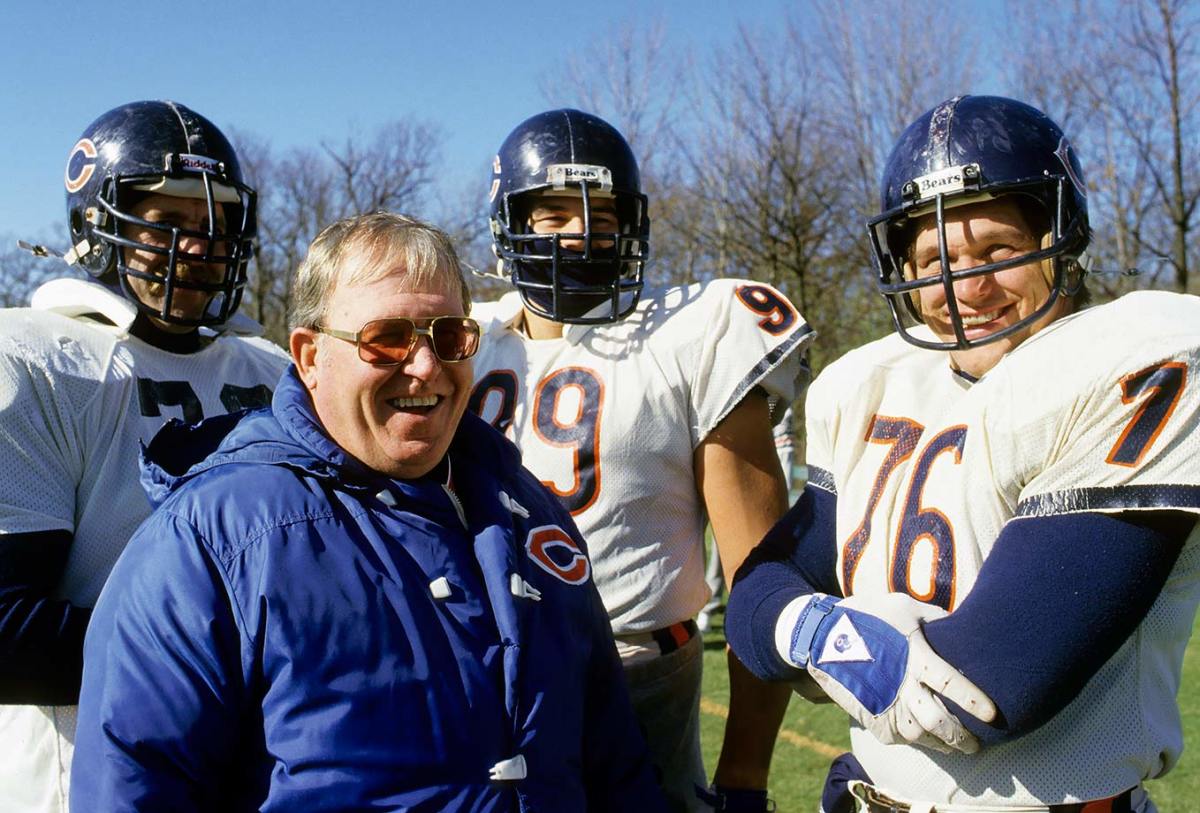
Chicago Bears defensive coordinator Buddy Ryan poses with defensive end Mike Hartenstine (73), defensive tackles Dan Hampton (99) and Steve McMichael (76) during practice on Nov. 16, 1984 in Chicago. Ryan’s coaching career spanned 26 years and six NFL teams.
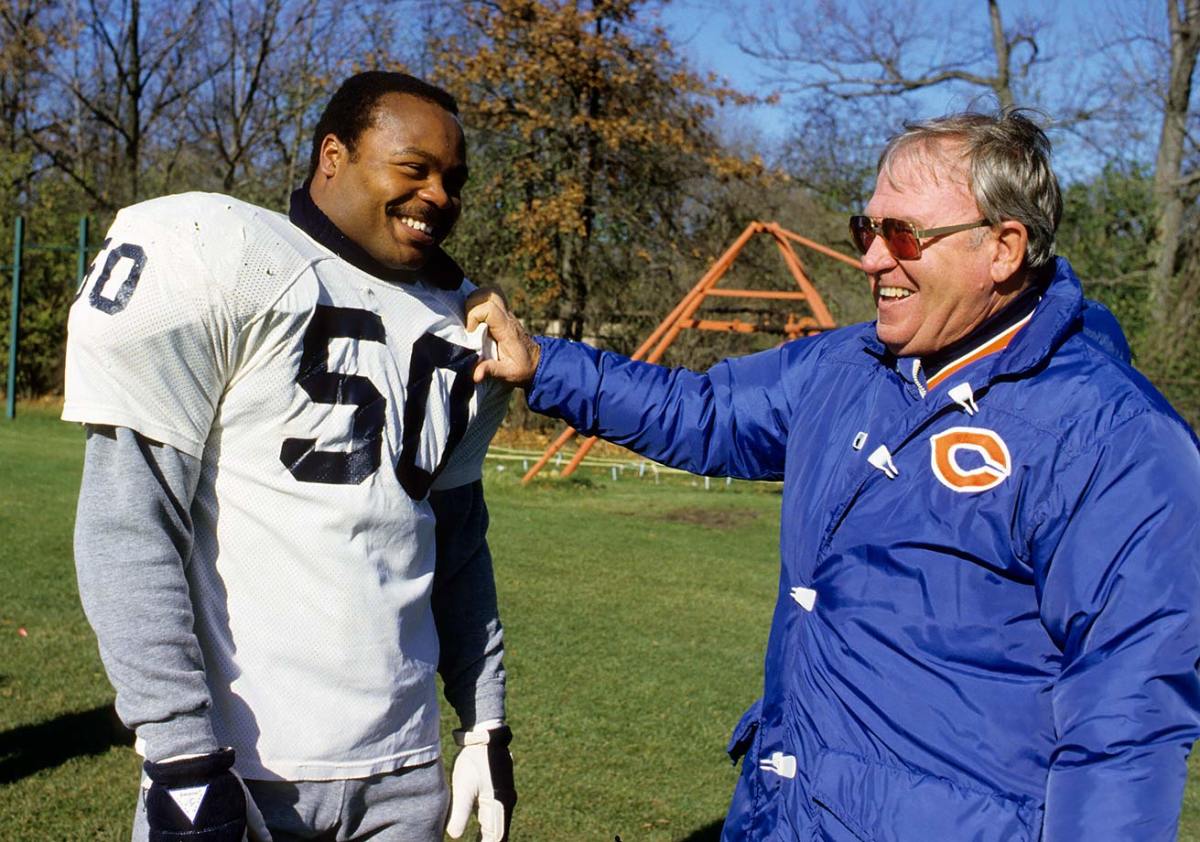
Chicago Bears linebacker Mike Singletary laughs with defensive coordinator Buddy Ryan during practice on Nov. 16, 1984 in Chicago. Ryan was the innovator of the vaunted 46 defense, that propelled the Chicago Bears to a dominating 46-10 Super Bowl victory over the New England Patriots.
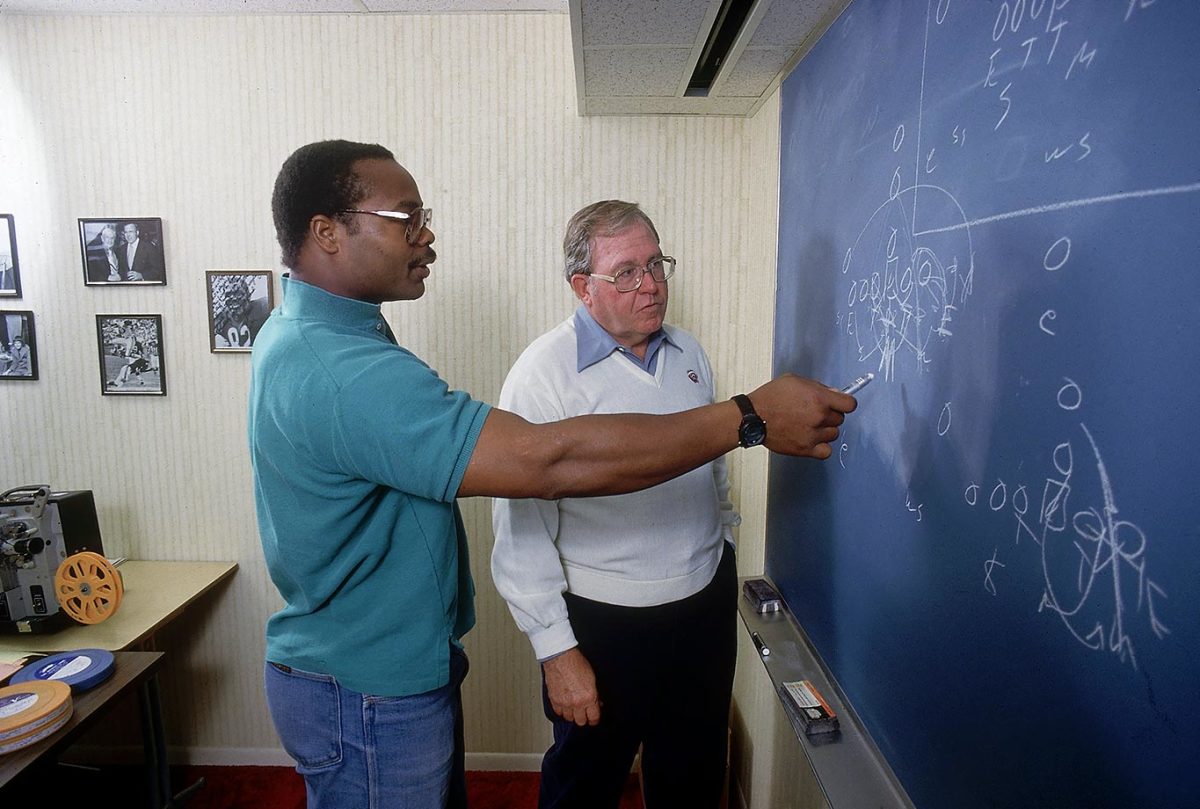
Chicago Bears linebacker Mike Singletary goes over some plays with defensive coordinator Buddy Ryan before a game against the Detroit Lions on Nov. 18, 1984 at Soldier Field in Chicago. •Ryan won two Super Bowls in his coaching career, the first in Super Bowl 3 with the Jets in 1969 in a 16-7 win over the Baltimore Colts.
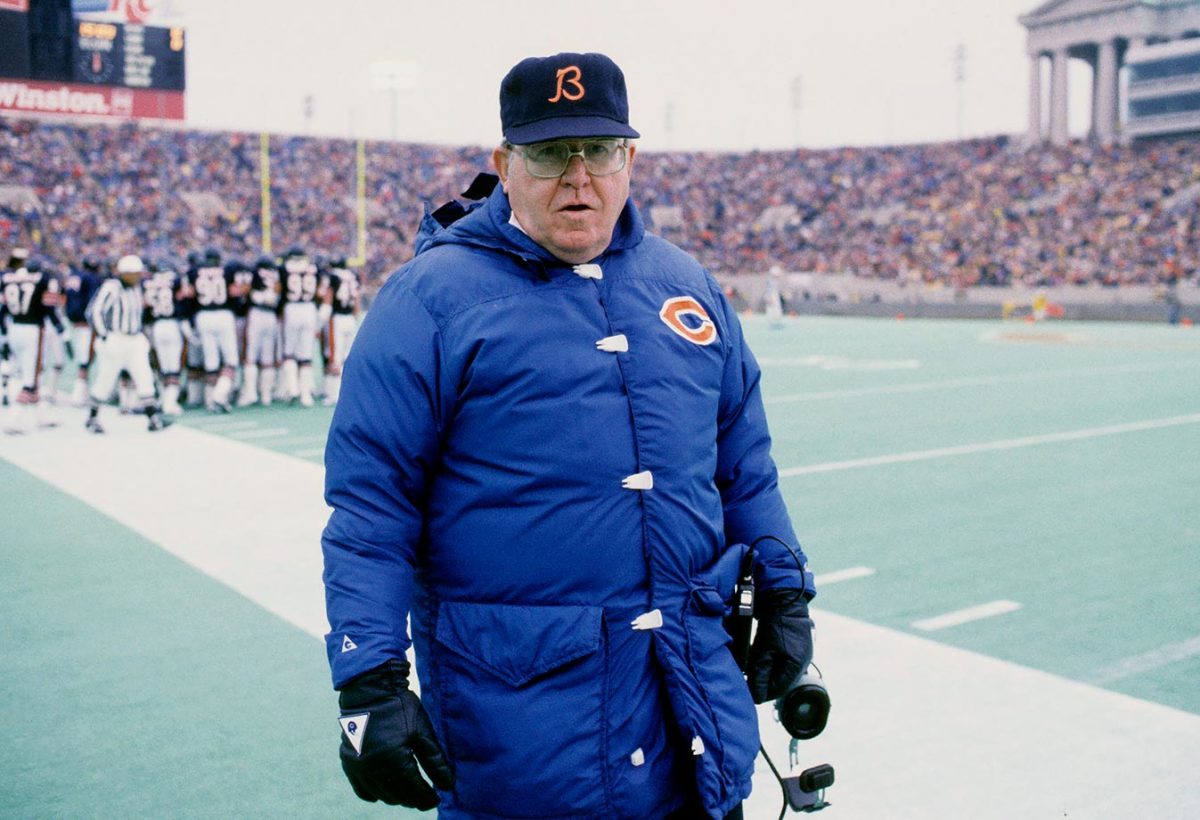
Chicago Bears defensive coordinator Buddy Ryan walks along the sideline during a game against the Detroit Lions on Nov. 18, 1984 at Soldier Field in Chicago. He took the Bears defensive coordinator job in 1978 at age 44.
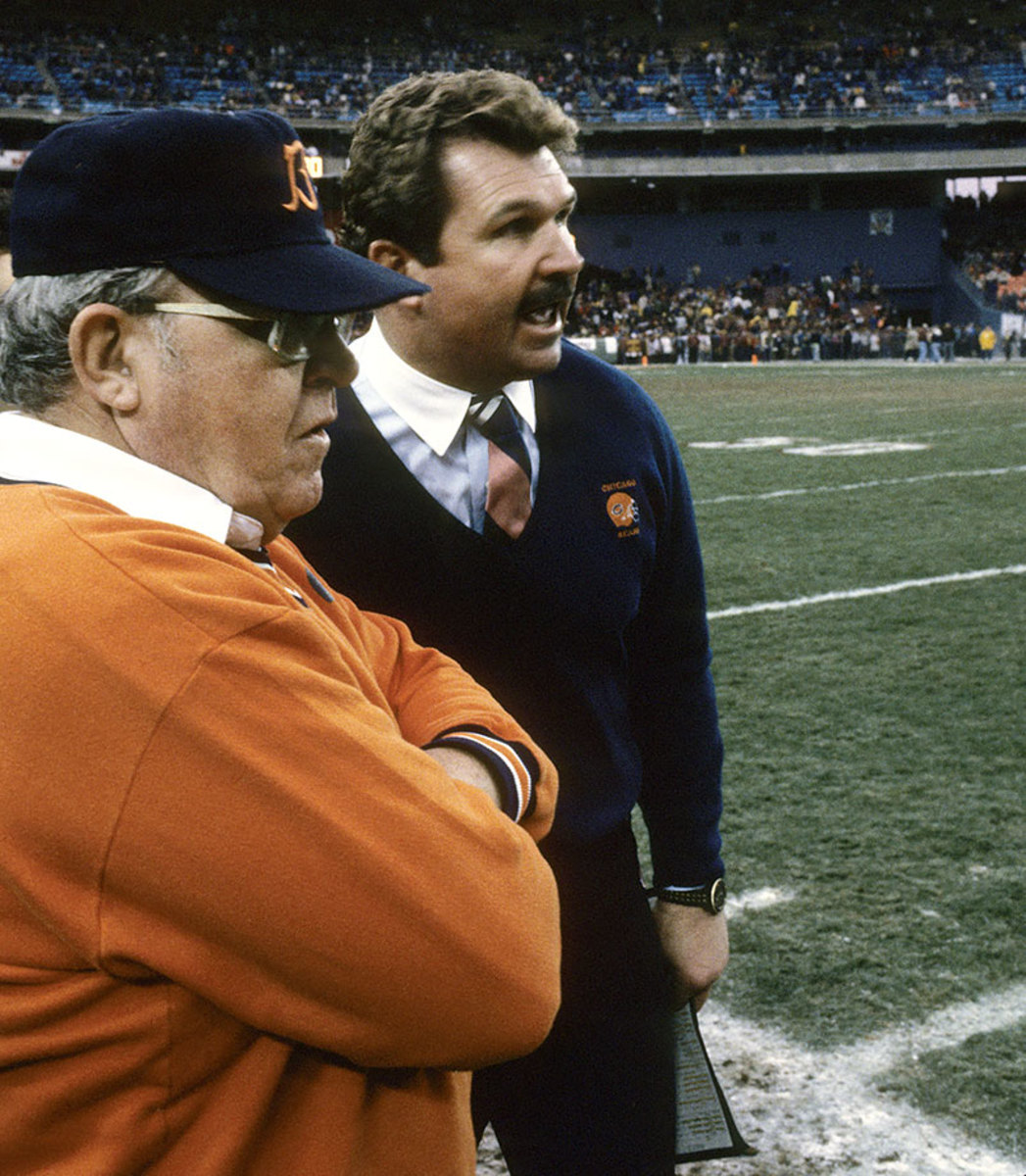
Chicago Bears defensive coordinator Buddy Ryan and head coach Mike Ditka watch the action from the sideline during the NFC Divisional Playoff game against the Washington Redskins on Dec. 30, 1984 at RFK Stadium in Washington, D.C. Ryan was born in small Frederick, Okla., on Feb 17, 1934.
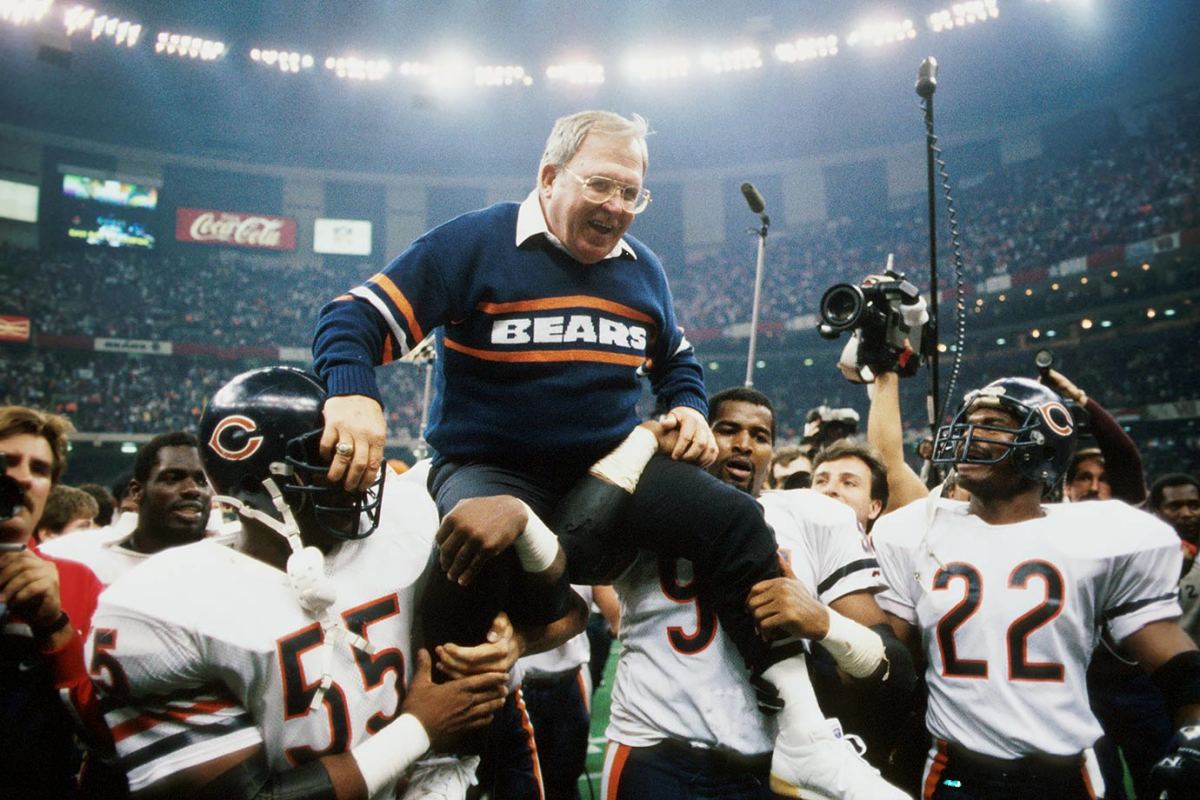
Chicago Bears defensive coordinator Buddy Ryan is carried off the field by linebacker Otis Wilson (55) and defensive end Richard Dent (95) as safety Dave Duerson looks on after the team's 46-10 victory over the New England Patriots in Super Bowl XX on Jan. 26, 1986 at the Louisiana Superdome in New Orleans. Ryan took a head coaching job with the Philadelphia Eagles after winning the Super Bowl.
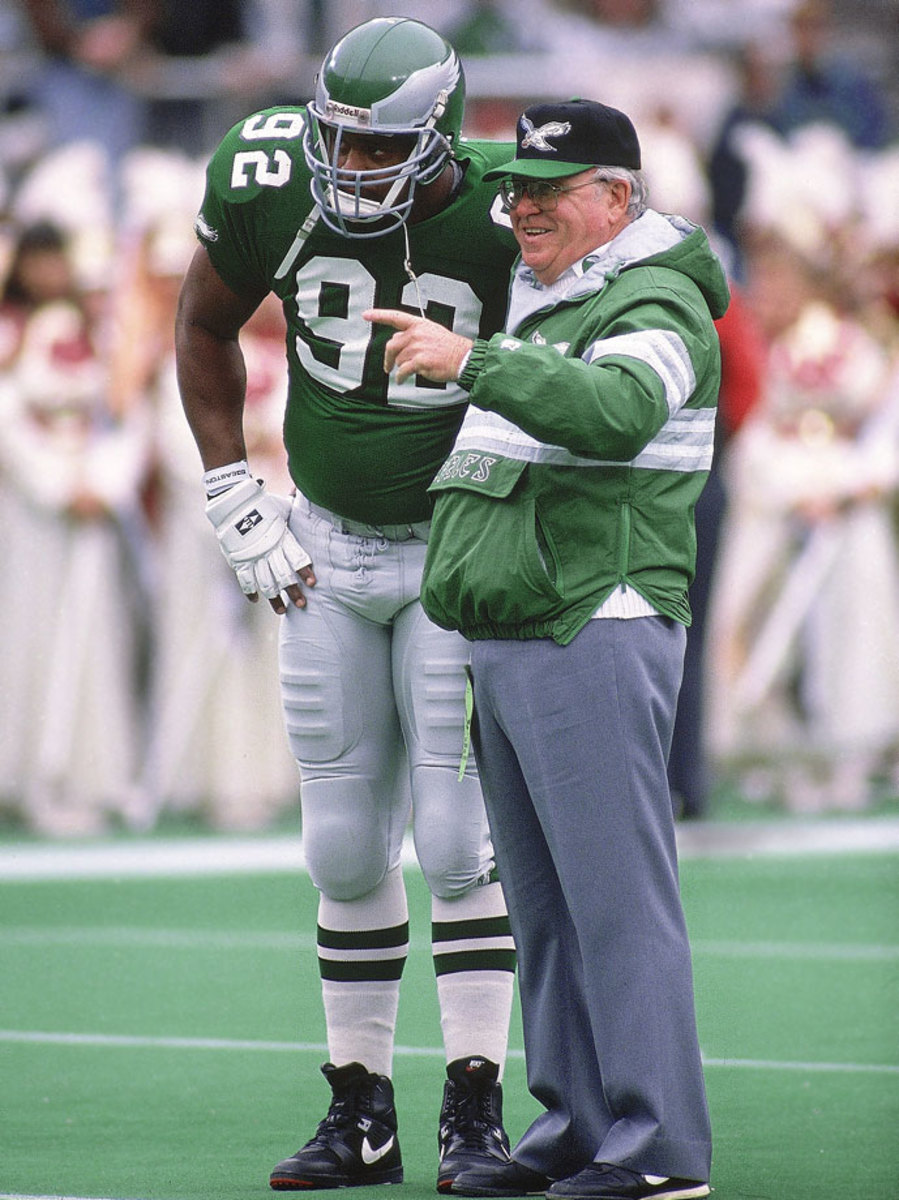
Philadelphia Eagles head coach Buddy Ryan chats with defensive end Reggie White before their NFC Wild Card playoff game against the Washington Redskins on Jan. 5, 1991 at Veterans Stadium in Philadelphia. Over his entire coaching career, Ryan compiled a 55-55-1 record.
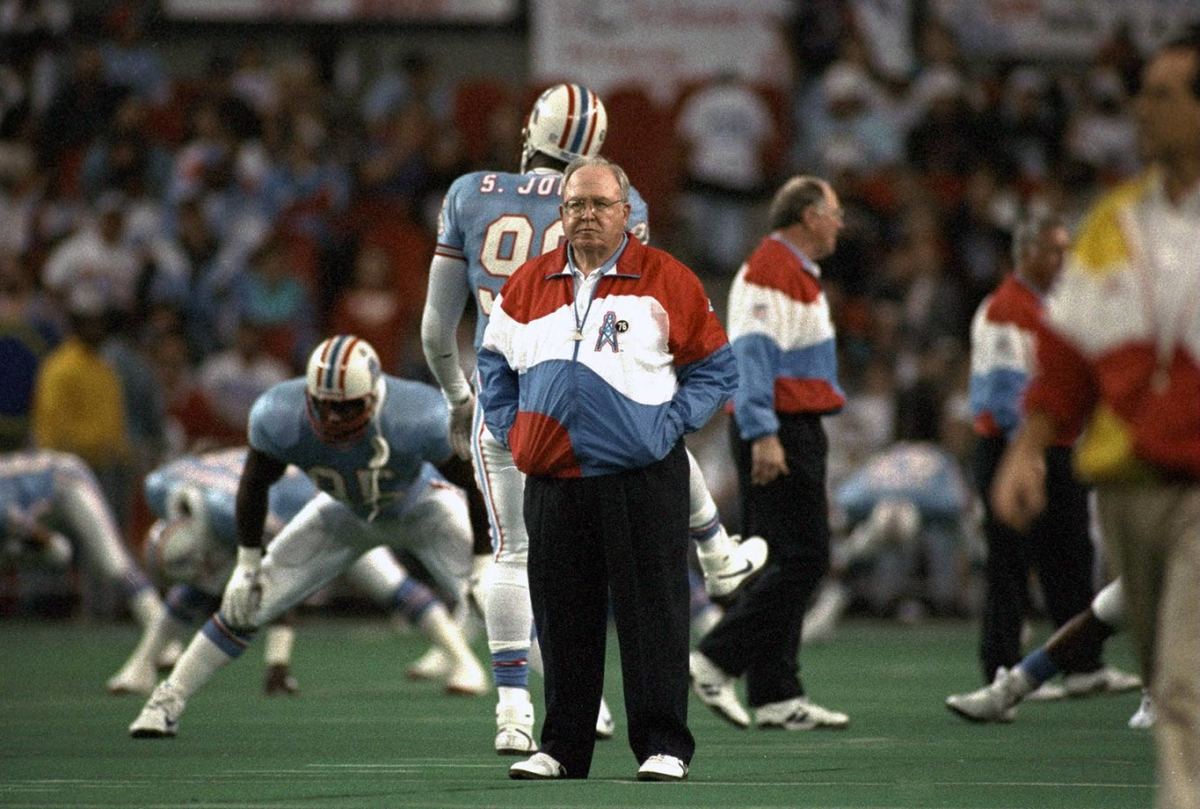
Houston Oilers defensive coordinator Buddy Ryan stands on the field before a game against the Kansas City Chiefs on Jan. 16, 1994, at the Astrodome in Houston. Ryan was a fireball, oft getting into arguments with his own coaching staff. In 1993 with the Oilers, he threw a punch at head coach Kevin Gilbride on national television.
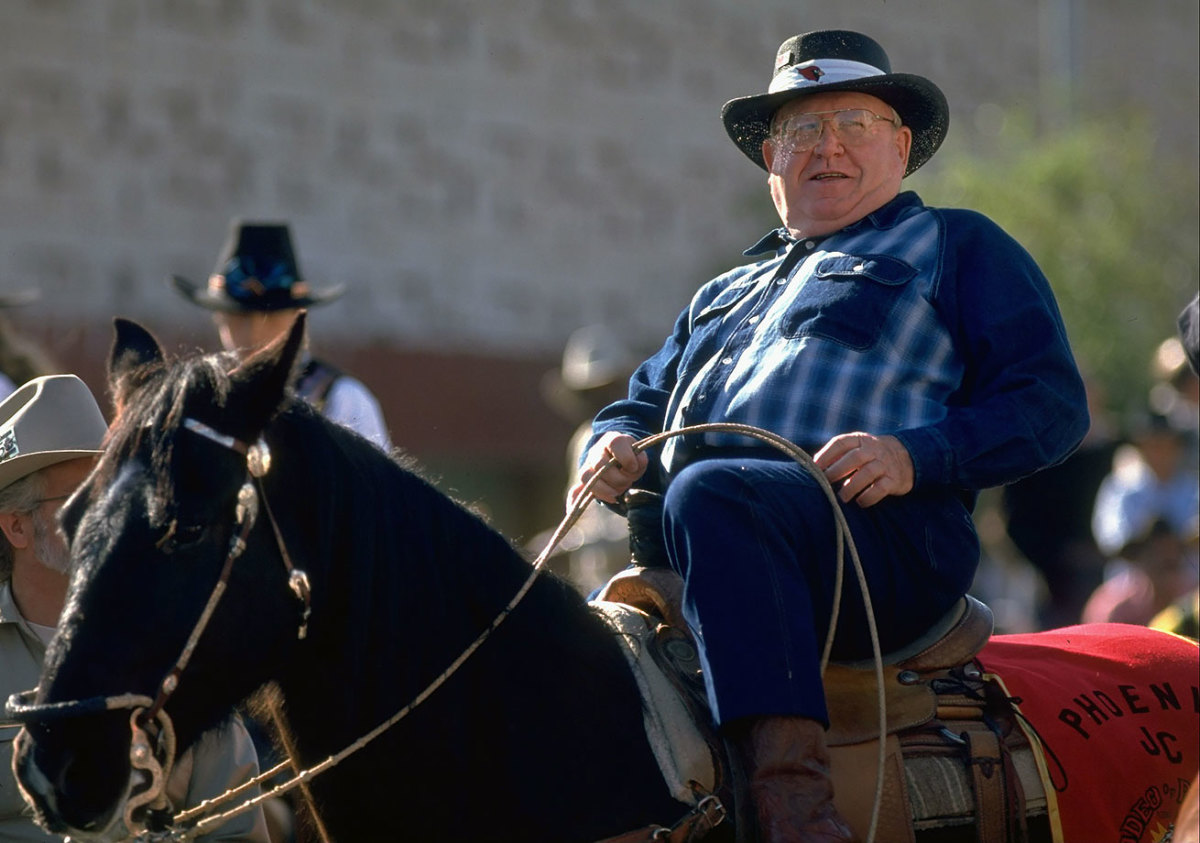
Arizona Cardinals head coach Buddy Ryan rides his horse during a parade after his hiring on March 4, 1994 in Phoenix. He was the head coach of the Cardinals for the 1994-1995 seasons, before retiring from coaching.
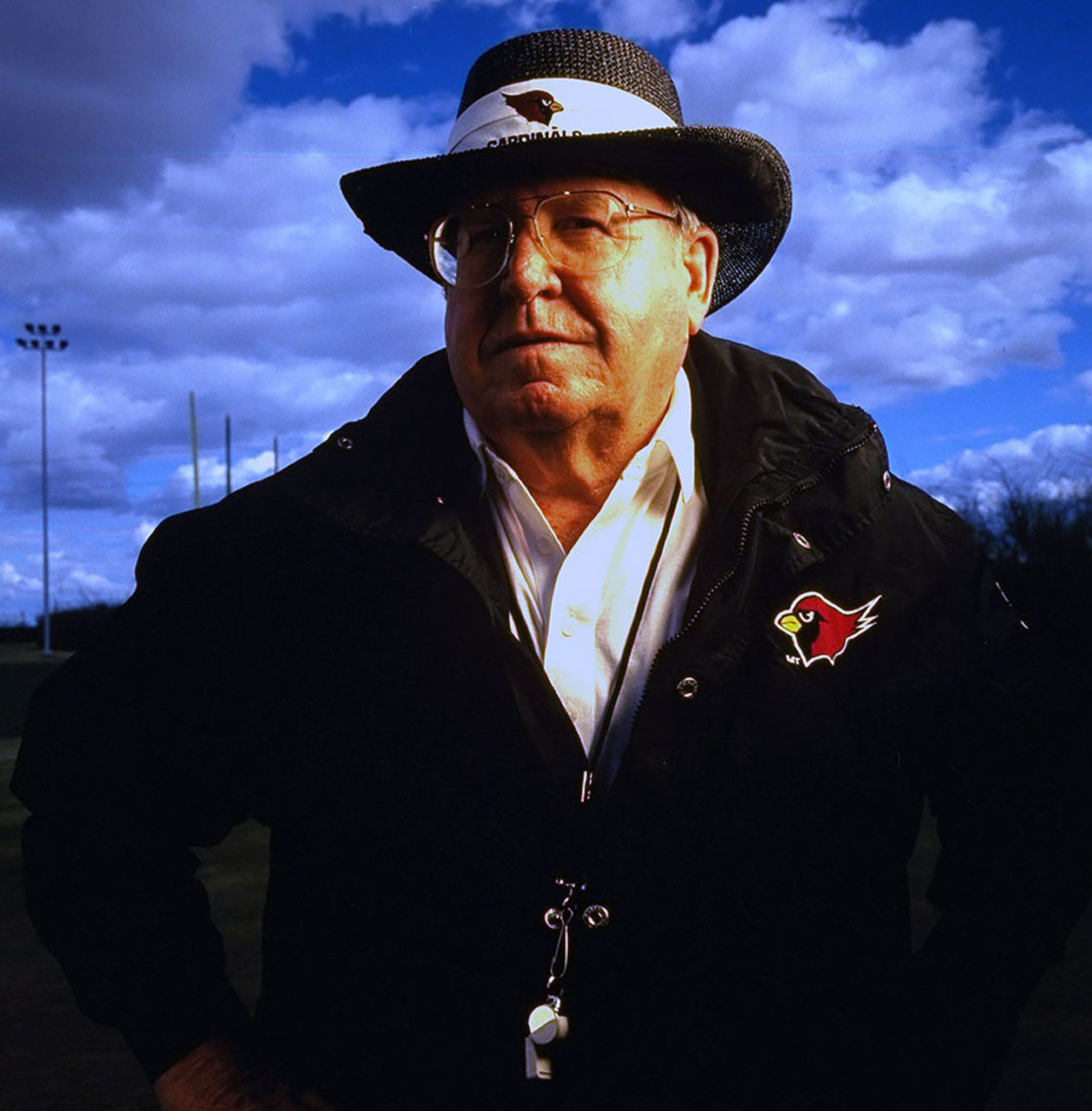
Arizona Cardinals head coach Buddy Ryan poses for a portrait on March 26, 1994 in Phoenix. Over his entire coaching career, he compiled a 55-55-1 record.
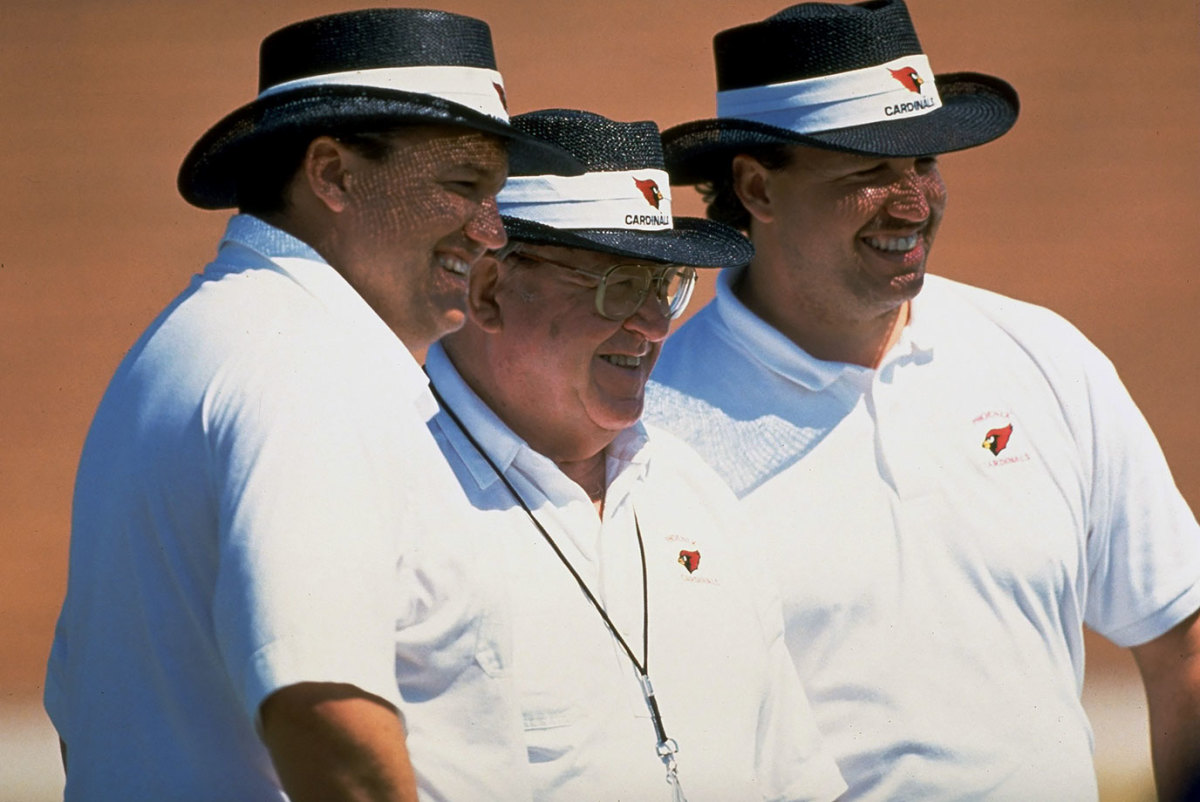
Arizona Cardinals head coach Buddy Ryan poses with his sons and assistant coaches Rob and Rex Ryan, during minicamp on March 26, 1994 in Phoenix.
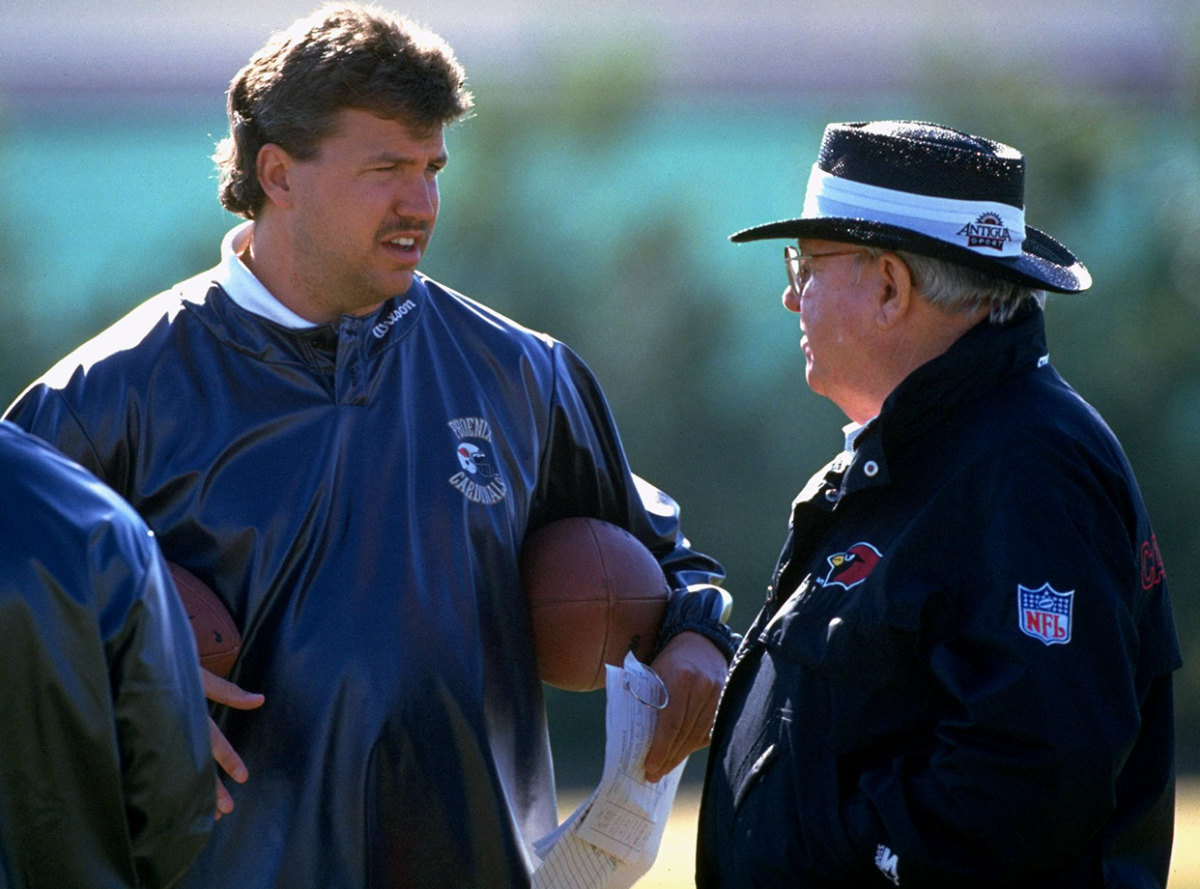
Arizona Cardinals defensive line/linebackers coach Rex Ryan talks with his father and head coach, Buddy Ryan, during minicamp on March 26, 1994 in Phoenix.
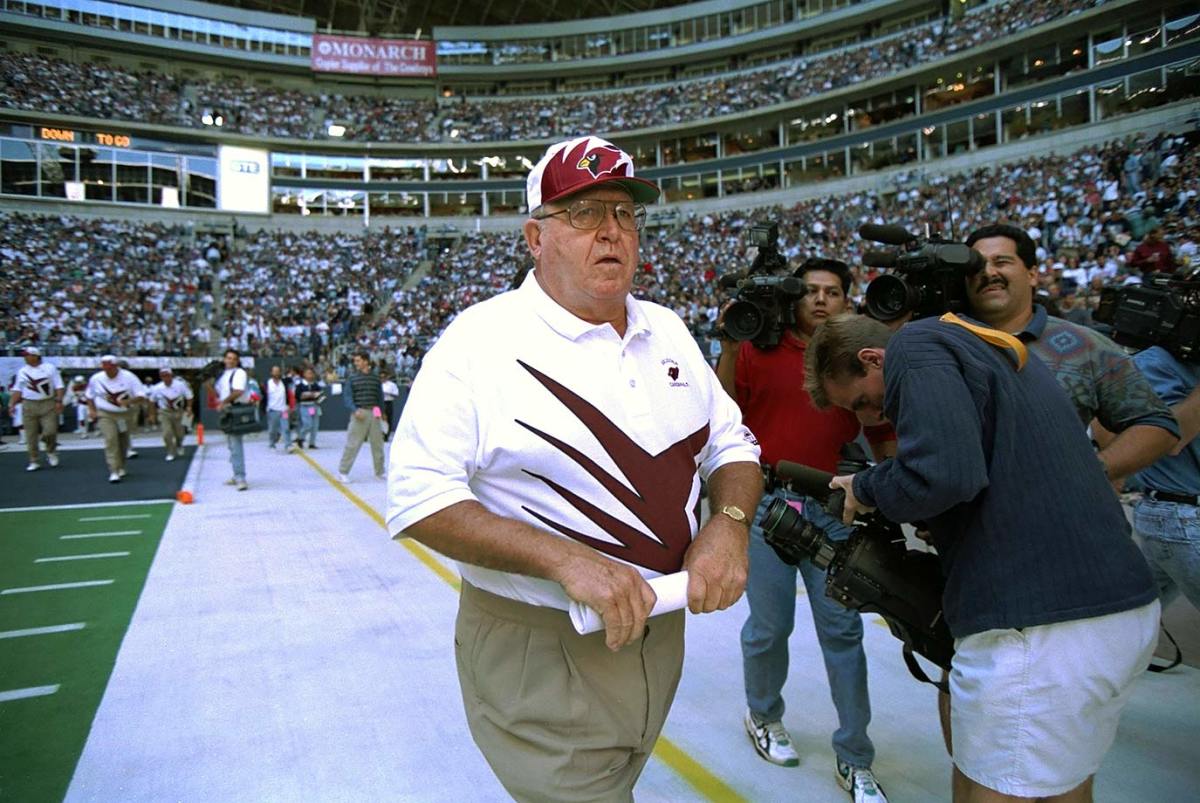
Arizona Cardinals head coach Buddy Ryan poses walks along the sideline before a game against the Dallas Cowboys on Oct. 9, 1994 at Texas Stadium in Dallas.
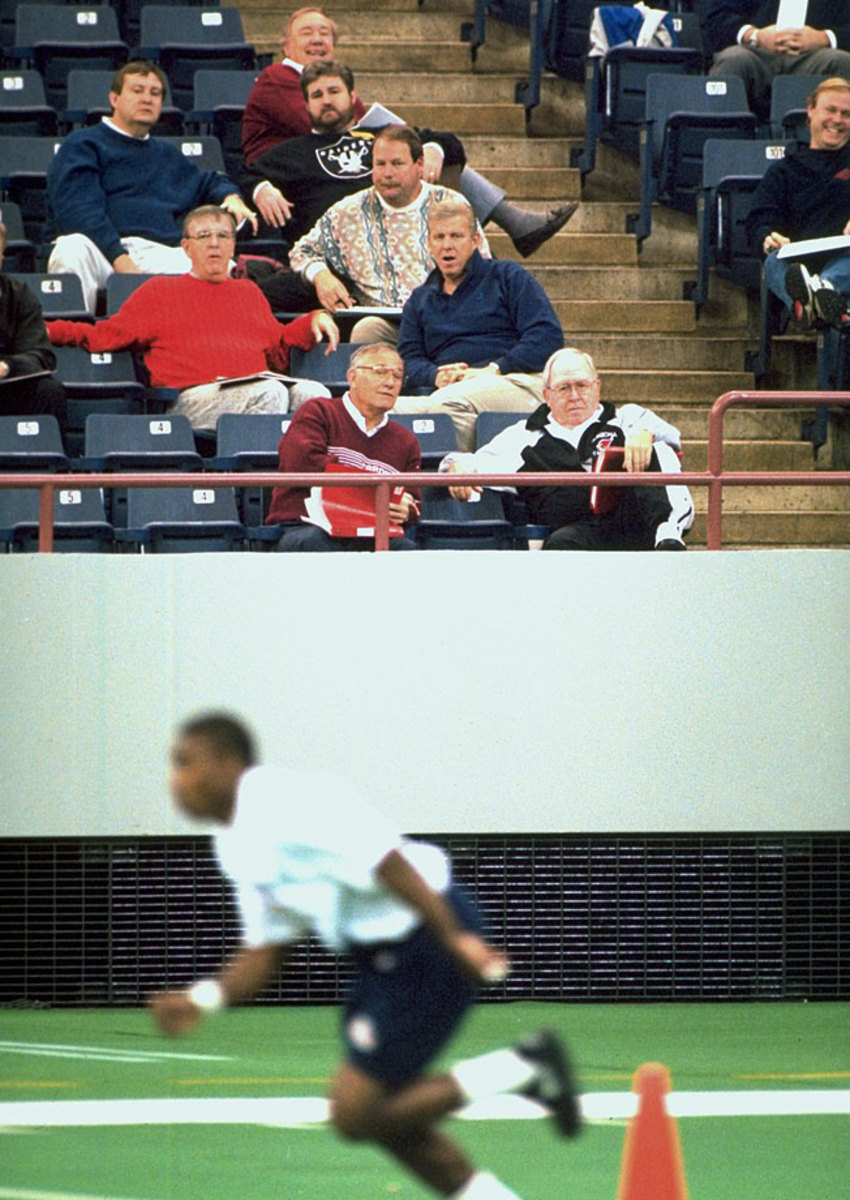
NFL head coaches Buddy Ryan (Cardinals), Bill Parcells (Patriots), Mike Holmgren (Packers) watch the NFL scouting combine from the stands on Feb. 11, 1995 at the RCA Dome in Indianapolis.
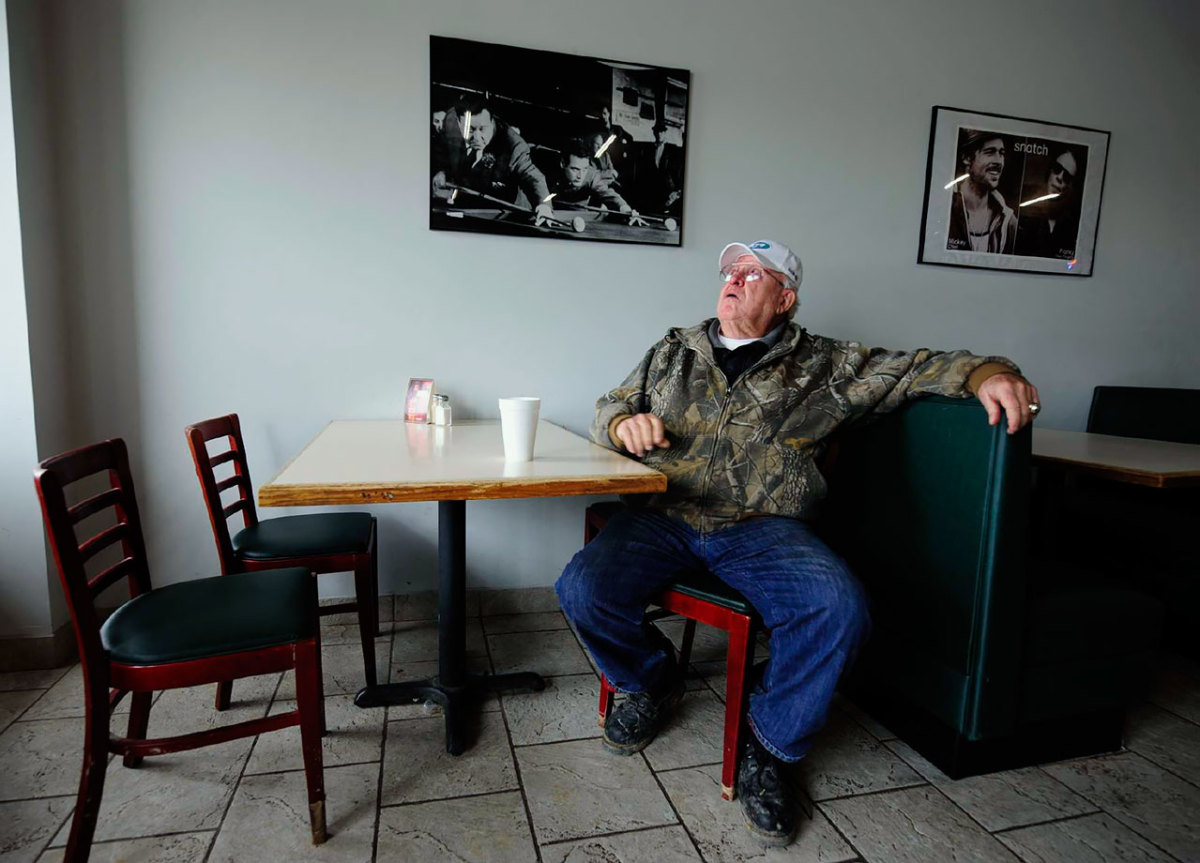
Buddy Ryan looks up at a picture of Jackie Gleason and Paul Newman from the movie "The Hustler" while sitting in a restaurant on April 21, 2009 in Simpsonville, Ky. When he retired he moved to a horse farm in Kentucky.
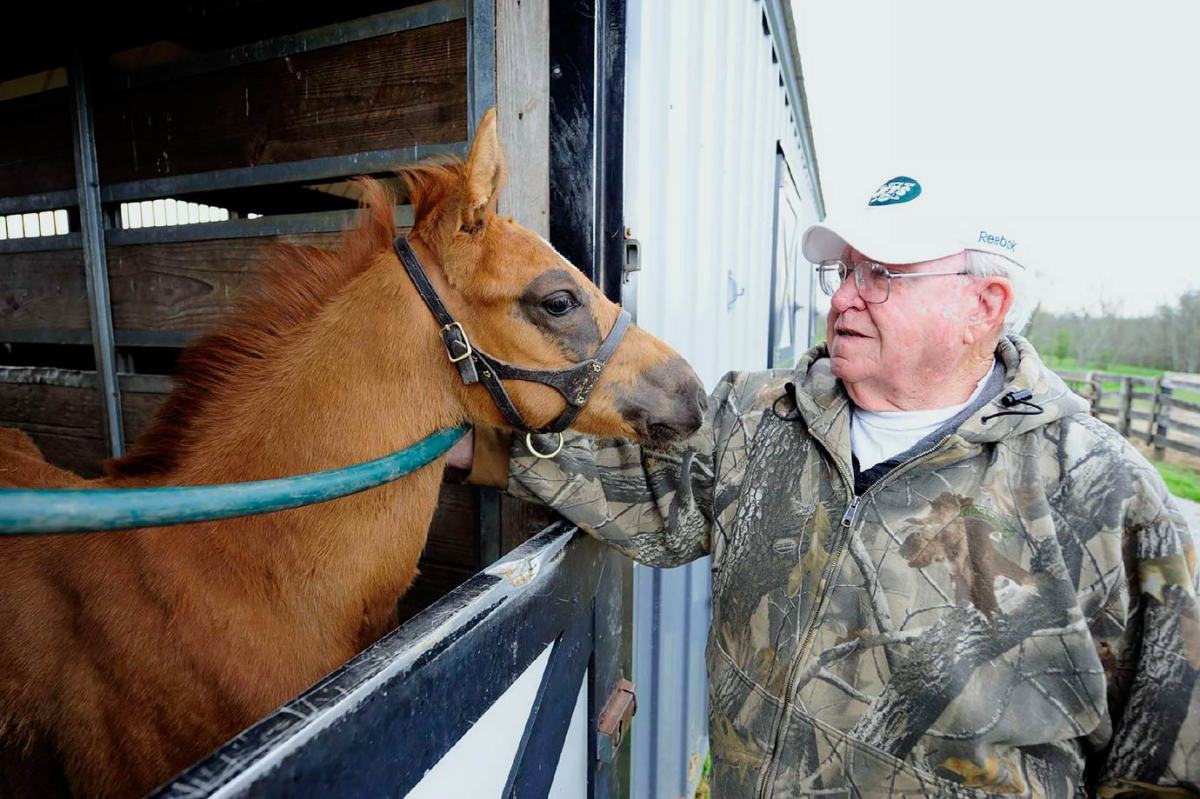
Buddy Ryan pets one of the horses on his ranch on April 21, 2009 in Simpsonville, Ky.
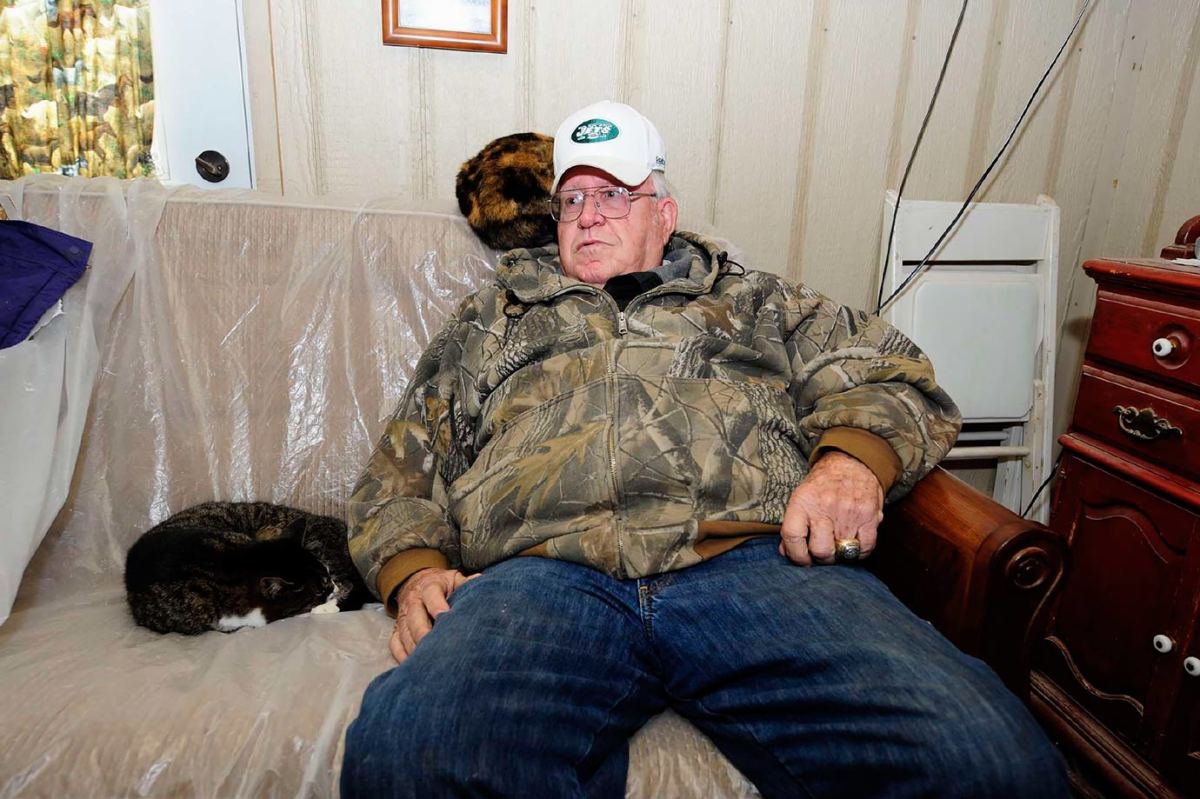
Buddy Ryan sits with cats at his home on April 21, 2009 in Simpsonville, Ky. Ryan is famous for saying, "Football kickers are like taxi cabs. You can always go out and hire another one."
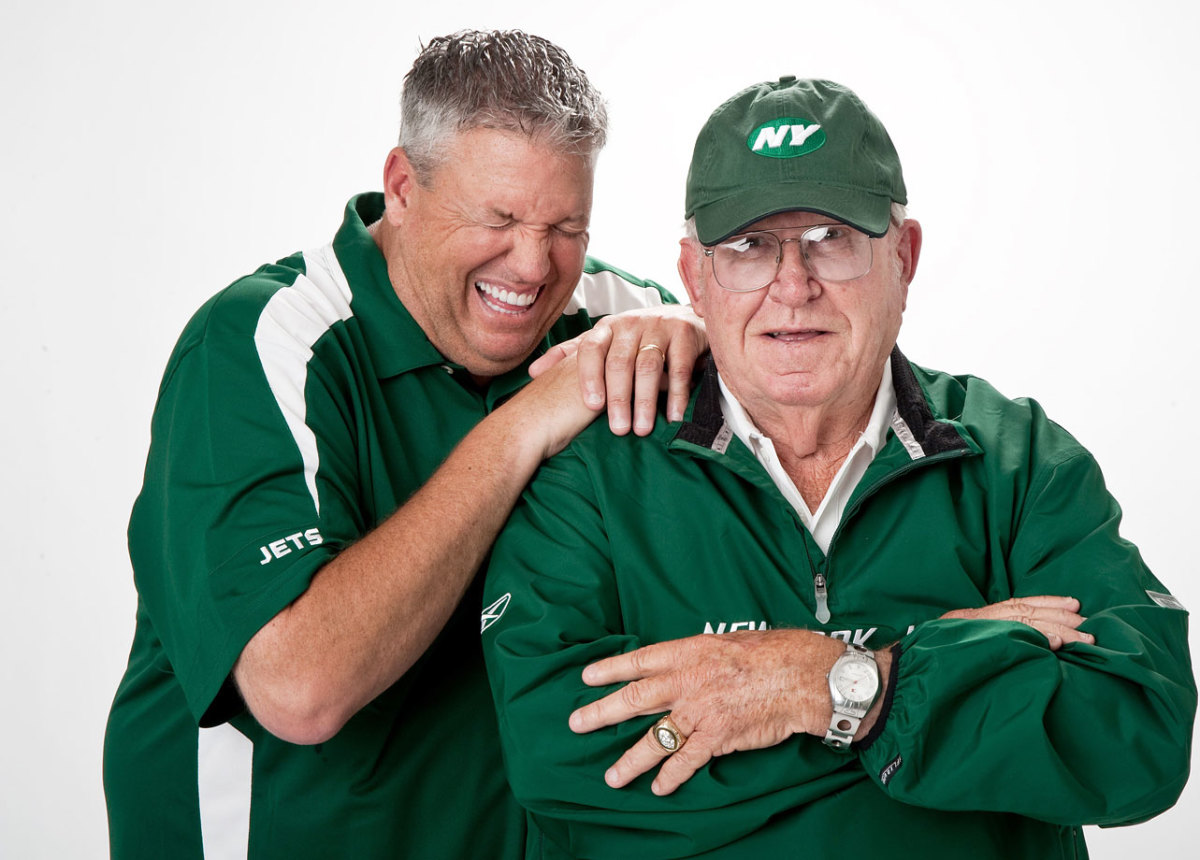
New York Jets head coach Rex Ryan laughs while posing with his father, Buddy, during minicamp on June 9, 2009 at Jets Training Center in Florham Park, N.J.
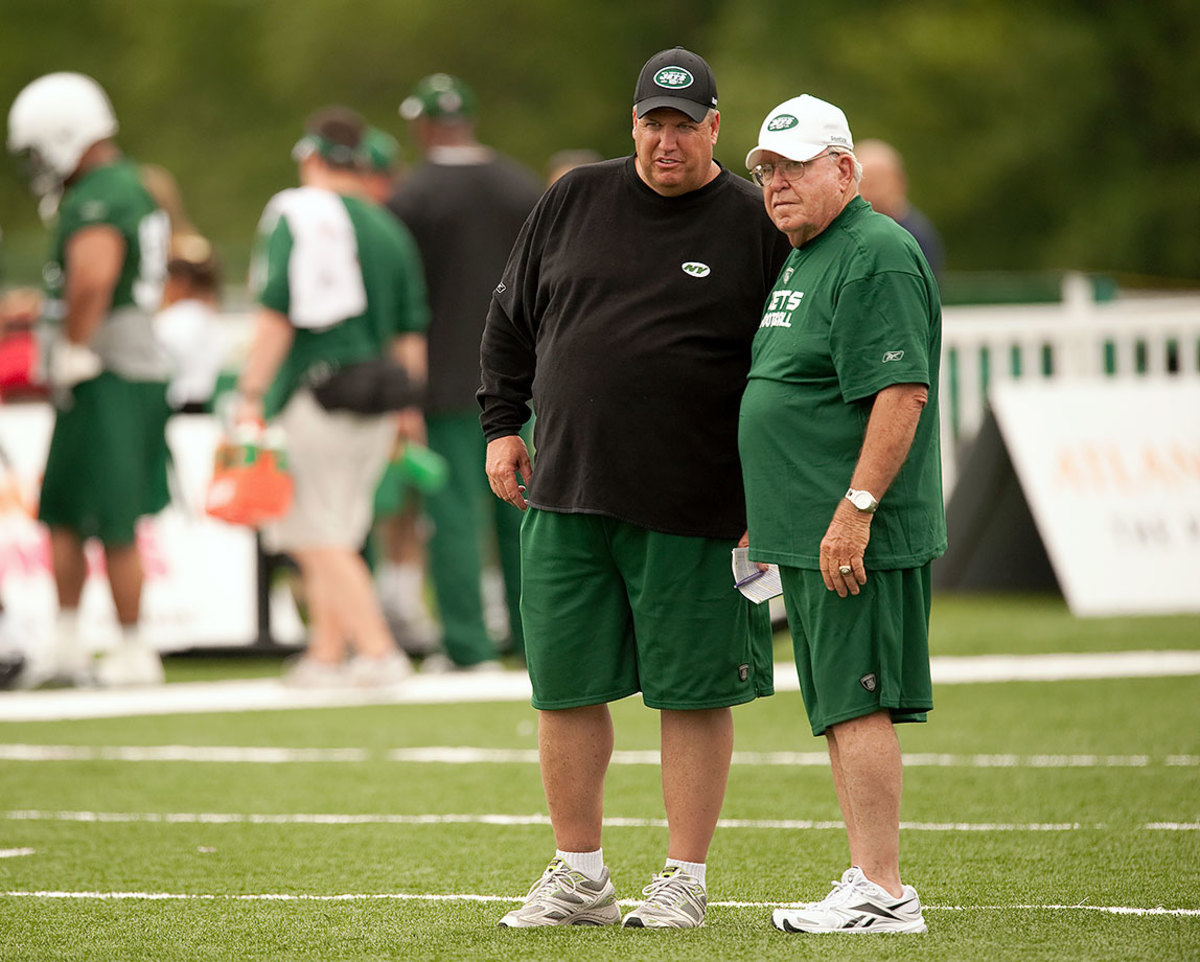
New York Jets head coach Rex Ryan stands with his father, Buddy, on the field during minicamp on June 9, 2009 at Jets Training Center in Florham Park, N.J.
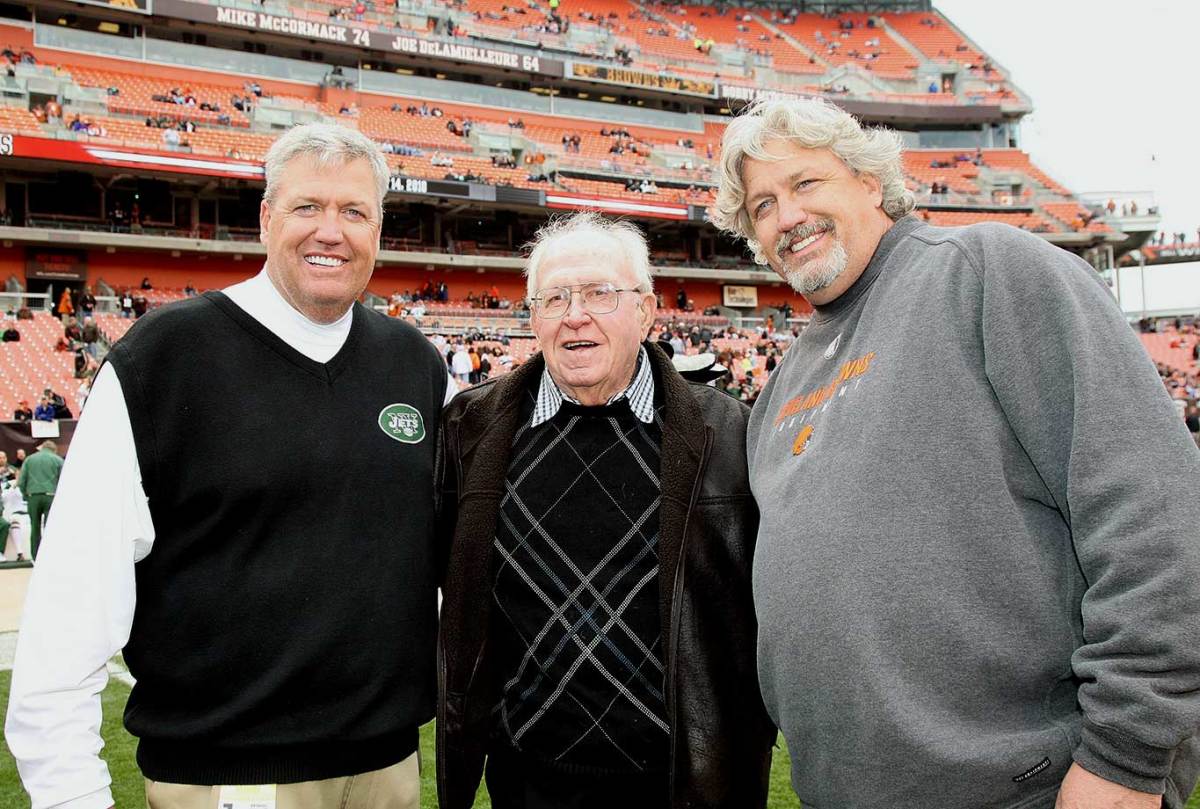
New York Jets head coach Rex Ryan and Cleveland Browns defensive coordinator Rob Ryan pose with their father, Buddy, before a game on Nov. 14, 2010 at Cleveland Browns Stadium.
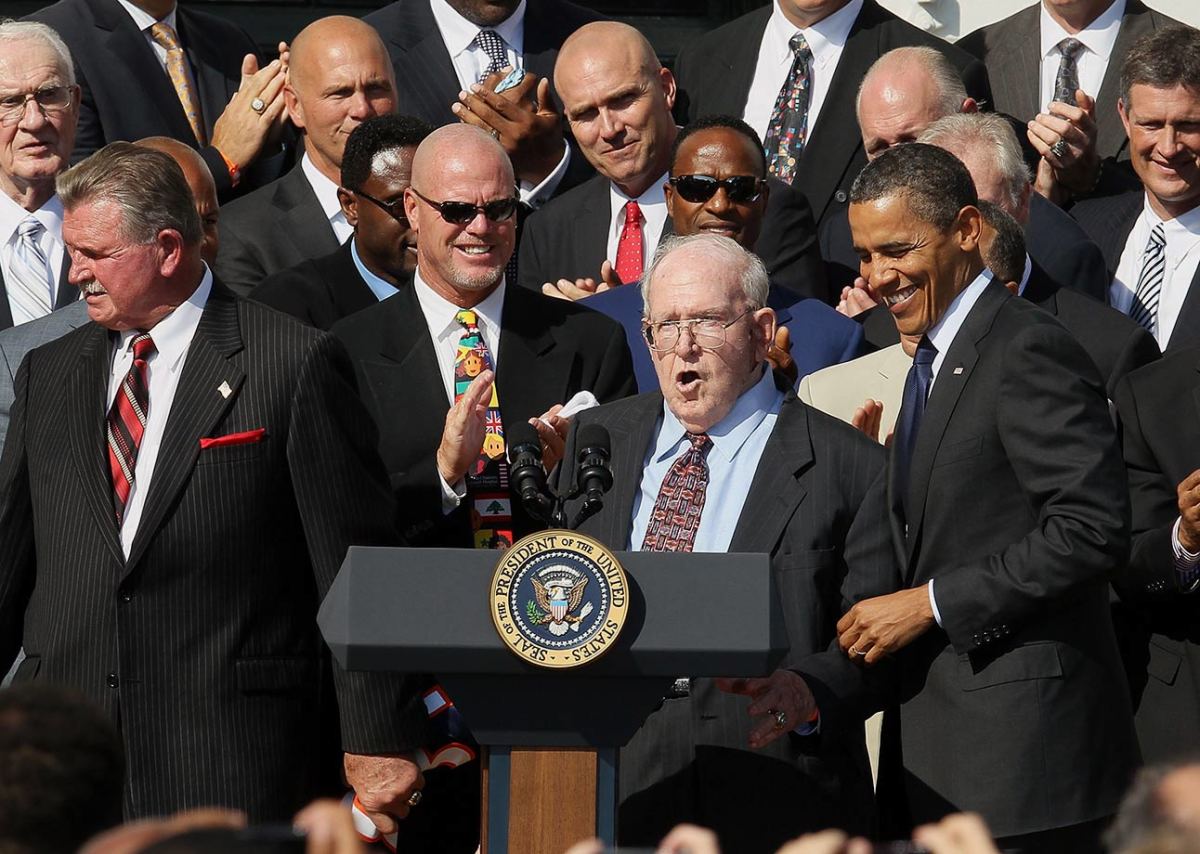
President Barack Obama, a Chicago Bears fan, stands with former Bears defensive coordinator Buddy Ryan in front of other members of the 1985 Super Bowl Championship team during a ceremony—the team never received 25 years earlier—on the south lawn of the White House on Oct. 7, 2011 in Washington, D.C.
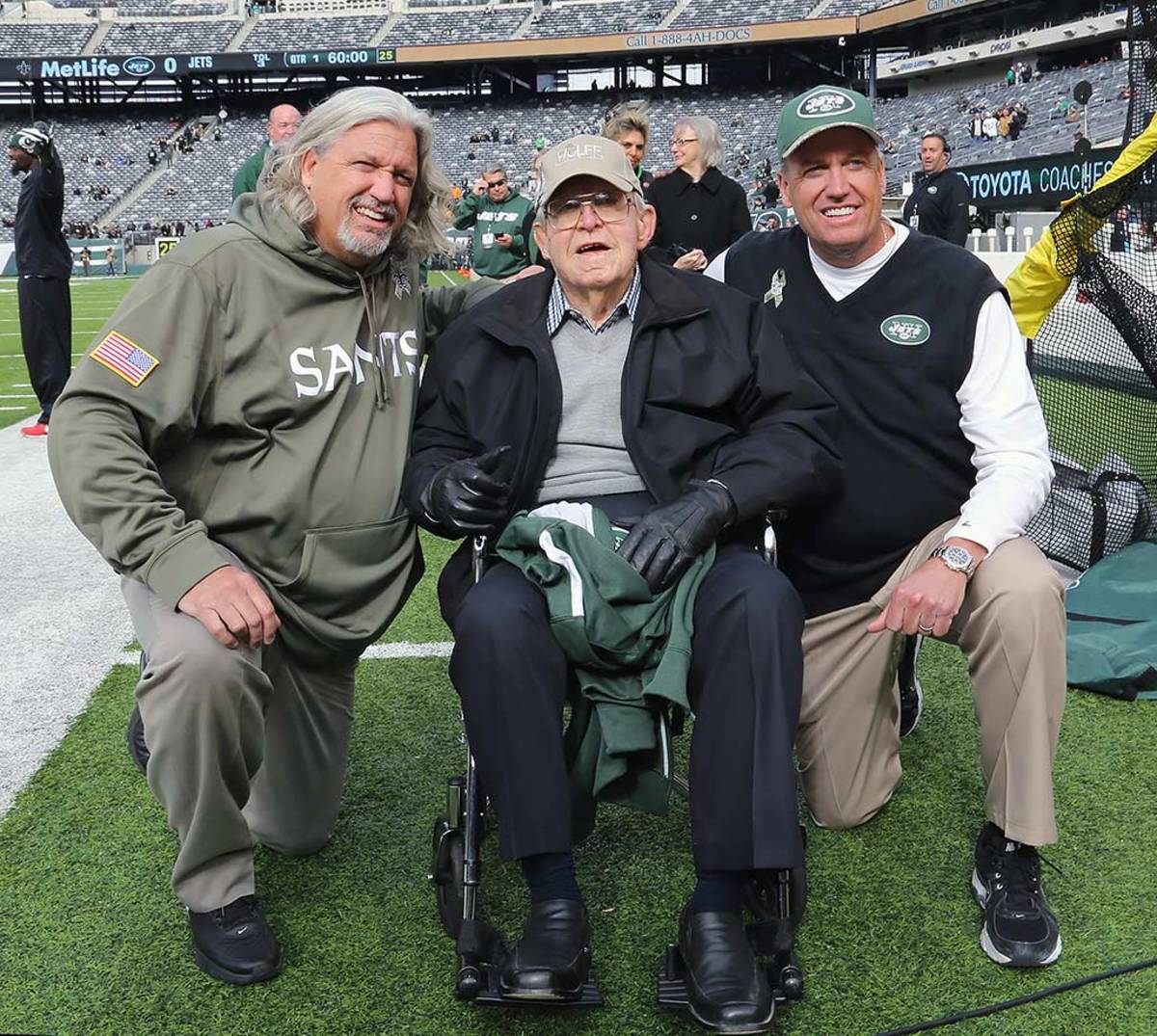
New Orleans Saints defensive coordinator Rob Ryan and New York Jets head coach Rex Ryan pose with their father, Buddy, before a game on Nov. 3, 2013 at MetLife Stadium in East Rutherford, N.J.
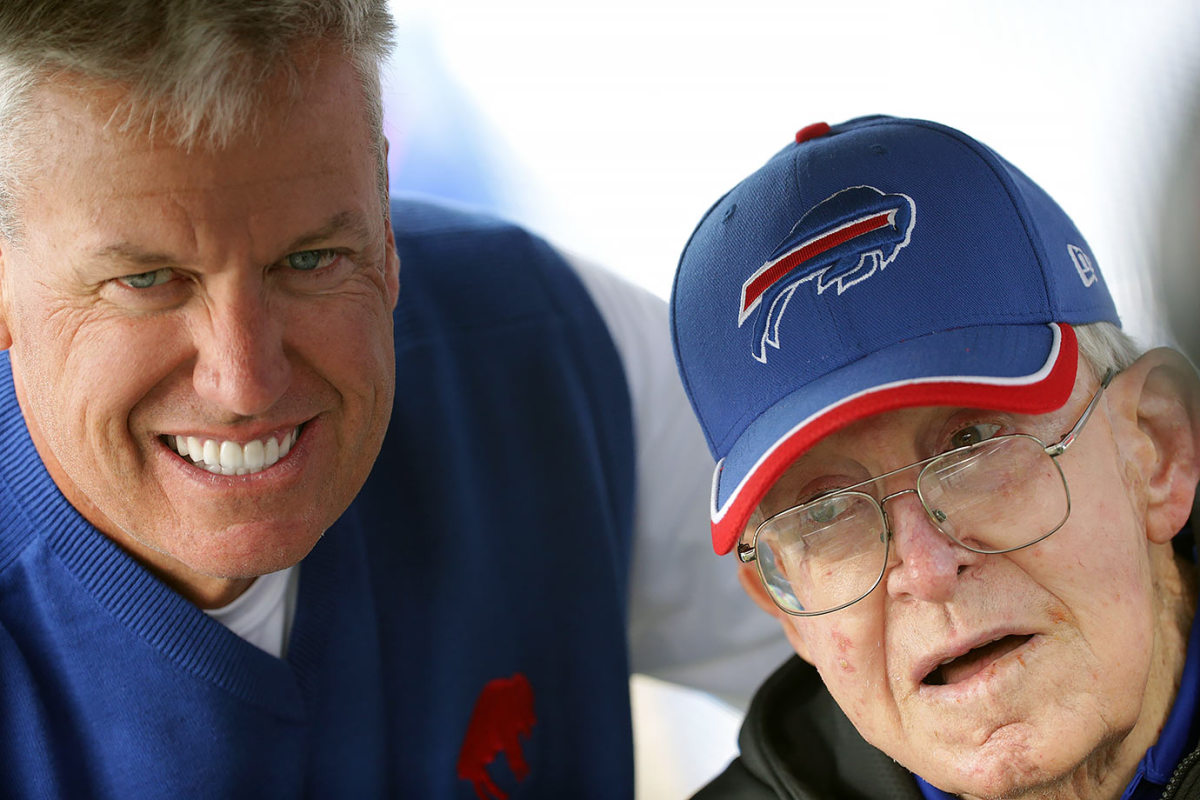
Buffalo Bills head coach Rex Ryan poses with his father, Buddy, before a game against the Indianapolis Colts on Sept. 13, 2015 at Ralph Wilson Stadium in Orchard Park, N.Y.
Shelbyville, Ky. April 2009
It has been spring for a month on the calendar, but there is winter in the air in the horse country of central Kentucky. A dark overcast sky spits out periodic snow flurries. The Kentucky Derby will be run in less than two weeks, but warm sunshine, fancy hats and mint juleps seem impossibly distant. Late in the afternoon Buddy Ryan pulls up in a dust-covered pickup truck alongside a horse barn where he rents stall space. He owns 16 horses—four broodmares, four yearlings born just this spring and eight colts. They are not the type of horses bred to win the Triple Crown, but they keep a man busy just the same. Ryan is wearing a Jets windbreaker (in honor of his son Rex’s recent hiring as head coach—as well as his own first job in the NFL) and shuffling with a limp because a horse stepped on his right foot a few days earlier. As he fills plastic feed tubs, he stops to point out a January foal he’s unofficially named Jetty.
Buddy moved here with his second wife, Joanie, in 1996, after the Cardinals fired him from what would be his last coaching job, but retirement hasn’t been all easy. Joanie was diagnosed with Alzheimer’s disease in 2001, and two years later Buddy moved her to an assisted living facility in Louisville. “She’s not doing good,” says Buddy on this day. “But we go to mass every Sunday, and she seems to like that, so it’s O.K.” In the winter of 2005 Buddy fought off a case of encephalitis. (Rex came down to Louisville and raised hell with the hospital staff, telling them, “This ain’t Johnny Bumf--- you’re treating here.”) The illness left some holes in Buddy’s memory, but not when it comes to football.
It was a long journey that had brought Ryan to that evening in New Orleans, sitting atop his players’ shoulders, the most famous defensive coordinator in football, and then carried him to this barn smack in the middle of Kentucky’s horse industry. The wind blows harder as Ryan moves from stall to stall, filling the feed tubs and making sure the horses have water, using a black rubber hose to fill up the pails.
The horses’ names tell the story of Ryan’s life. One broodmare is named Bayside Girl, for Joanie, who was born and raised in Bayside, Queens. Another mare is Fired for Winning, which happened when Ryan was dismissed as coach of the Eagles following the 1990 season. One colt, still actively racing at the time, is named Forty-Six Blitz. That one makes Ryan smile. Buddy always wanted to raise horses, so when his coaching career finally ended, he brought Joanie to the green hills and bought some stock.
After the horses are fed and watered—“put up,” in the parlance of the business—Ryan drops onto a couch in a cluttered tack room just off the shedrow. Two wary cats scurry to cuddle at his feet. “So what do you want to know about the 46?” he asks. “There wasn’t all that much to it at first.” He laughs, because of course there was a lot more by the end.
Raised in the Oklahoma panhandle town of Frederick, Ryan was a lineman on the local high school team, but after graduation, instead of taking his game to college, he enlisted in the National Guard. “I went in when I was 16,” Ryan told Sports Illustrated in 1986. “No one had much money back in Frederick, so a bunch of us joined the National Guard to get that extra $40 a month. Then the sumbitches went and mobilized us.” At 18 he was a master sergeant, leading a platoon in Korea.
Ryan was back home before his 19th birthday, a grown man, and a lineman at Oklahoma A&M, which would later become Oklahoma State. “I was more mature than most of the other players,” he says. “You would expect that.” There he met his future wife, Doris, the homecoming queen, and they were married while still in college. Buddy became a coach, first in high school and then in college, 12 years at six different addresses.
• From the Vault (1994): Buddy Ryan inspires both love and hate
Ryan’s first NFL job was with the 1968 New York Jets. Weeb Ewbank had three assistant coaches on that team, and Ryan ran the defense that would eventually shut down the Colts 16–7 in Super Bowl III, shocking the football world. “We really weren’t very creative on defense with that team,” says Ryan. “We played a straight 4–3 and tried to gap teams a little bit. Offset some. Get off the ball quick.” This would become a Ryan signature, using linemen who were too quick off the ball to be easily blocked to disrupt offenses trying to control the line of scrimmage. On that Jets team, Ryan did it with defensive end Gerry Philbin and tackle John Elliott.
“We had a great defense on that team,” says Ryan, “but the coaches didn’t call nothin’. [Middle linebacker] Larry Grantham called all the defenses. But there wasn’t a whole lot to it. Like I said, we weren’t creative, but we were pretty good. Everybody found out in that Super Bowl.”
Ryan stayed in New York for eight seasons before Bud Grant hired him in 1976 to run the Minnesota Vikings’ defense. The Vikings made the Super Bowl in Ryan’s first season with Grant but were beaten by the Oakland Raiders 32–14 in a game that was never close. “We got beat clean,” says Ryan. When reminded that Hall of Fame wideout Fred Biletnikoff had a good game against his defense, Ryan sniffs. “S---, everybody had a good game.”
Ryan spent just one more season in Minnesota before Neill Armstrong brought him to Chicago as defensive coordinator. “That,” Ryan says, “was the first time I was a true defensive coordinator.” It was not necessarily an enviable job. The proud Bears possessed eight NFL titles, but none since 1963 and just one since 1946. They had gone 9–5 in the previous year under Jack Pardee, and that had been the team’s first winning season in a decade. Ryan assessed his hand quickly. “When I got there,” he says, “we didn’t have many good players.”
History will hold that Ryan was a genius—in that generous way the noun is applied to coaches—both as a motivator and strategist. It will less likely declare him a thoughtful, engaged, defensive scientist who loved nothing more than to doodle formations on a chalkboard, an inveterate tinkerer. But that indeed was Buddy Ryan. Some of those chalkboard creations were modest, variants on the standard; others were outlandish. Many would never find their way into a game. But throughout his career Ryan loved to play with schemes. In his early years with the Bears, as the team struggled to build an identity with marginal players, Buddy’s blackboard got a workout. The team went 7–9 in 1978, Armstrong’s, and Ryan’s, first season, and were 4–5 through October of the ’79 season, preparing for a home game against Detroit, when Ryan drew up the 46 during a defensive team meeting.
Doug Plank was then a fifth-year pro from Ohio State, an undersized hit man (listed at 6 feet, 200 pounds, but smaller in reality) who, as starting free safety, would throw his body recklessly around the field. (Plank would later explain his style: “I had to play a certain way,” he said in a 2009 interview. “And once I started playing that way, I developed a reputation for playing that way, and I had to protect that reputation.” He admitted to often experiencing foggy memory now.)
Plank sat in every one of Ryan’s defensive meetings in 1978 and ’79. “In those years, and even beyond,” says Plank, “Buddy was very creative. Every week he would come up with some sort of new defense. He was always trying new things. Most of them didn’t last very long. So this one day he puts this defense up on the board where I move up from free safety to middle linebacker, along with some other shifts and changes. We’re getting ready to leave the room, and one of the guys says, ‘What are we going to call this one?’ Well, Buddy was always drawing up packages but never drew them up with peoples’ names or with X’s and O’s. He would always just write numbers.”
Ryan circled Plank’s number 46 several times, over and over, and then said, “We’ll call it ‘46.’ ”
“Now, at this point,” says Plank, “a marching band did not come into the room and start playing music because of the invention of the 46 defense. At that point none of us knew if the 46 was going to be around any longer than some of the others, and that might be one game or one quarter or one snap. But it turns out that the 46 worked a little better than some of the others.”
Ryan says, “I was just trying to screw up teams’ blocking schemes until we got some better players. In ’79, when I first started messing with the 46, it wasn’t really a scheme at all, it was just something we tried. We had to do something. And it did mess up some of their blocking patterns. Then we got better at it. And then we got real good at it when the players were better.”
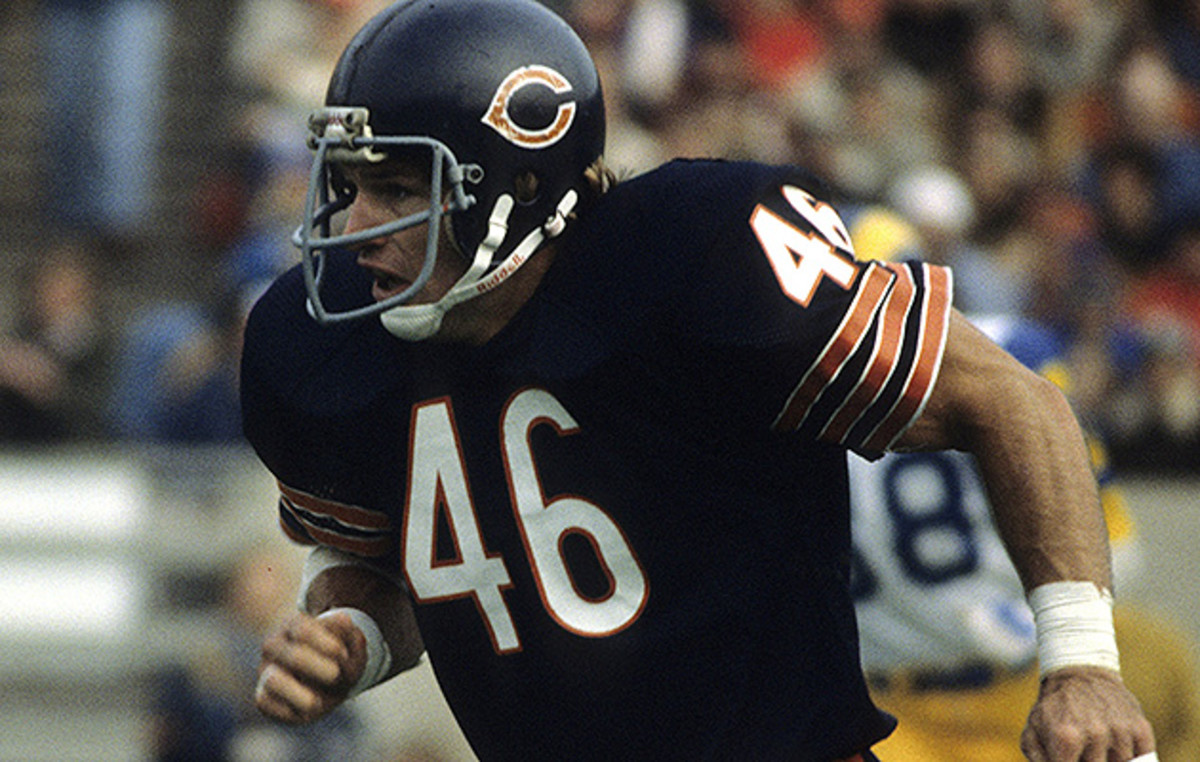
Sitting in the tack room of the horse barn in Kentucky, Ryan grabs a writer’s notebook and draws up the 46, narrating as he scribbles. Now he writes X’s and O’s, not numbers—after all, he has no team, no jerseys. But the task is so familiar that it takes just a few seconds. Like any good defensive coach, the last thing he does is count the symbols, making sure there are 11, which there are.
The 46 was a 4–3 defense, the base alignment Ryan liked best. But it was much more than a 4–3. The 46 was the first defense in modern football in which three interior linemen covered the center and two offensive guards, forcing the offensive linemen to block one-on-one and thus limiting their ability to move or help elsewhere. (Customarily, in a 4–3 defense, the center is uncovered and free to assist in double-team blocks or picking up blitzers. In a 3–4 defense, the defensive ends are usually lined up over the offensive tackles, leaving the guards uncovered.) Those first three Bears linemen, in 1979, were Alan Page (who had spent most of his career in Minnesota and would land in the Hall of Fame), Jim Osborne and Dan Hampton. The fourth defensive lineman, effectively the weakside defensive end, would line up outside the tackle assigned to block him. Behind the front four Ryan moved two linebackers to the tight end side and brought one safety—Plank—up as a fourth linebacker. That was the 46. “Now they call it ‘eight in the box,’ ” says Ryan.
The 46, even in its infancy, had two primary goals: One, stop the run. Eight in the box (four linemen, three linebackers, one safety) will do that. Two was to position the defense to bring more pressure on the quarterback than the offense can block. As the scheme evolved, that aspect would become more effective. “Eventually,” says Bruce Coslet, who coached against Ryan as defensive coordinator for Cincinnati through the mid- and late-1980s, “the 46 became a f---ing nightmare to coach against. It was something nobody had seen and nobody knew how to prepare for it. Buddy changed football with that defense.”
On Nov. 4, 1979, the Bears beat Detroit, 35–7. They won five of the next six games to finish the regular season with a 10–6 record; two days before Christmas they lost to the Philadelphia Eagles in the first round of the playoffs. A year later they slipped to 7–9 and in 1981 they went 6–10 after losing 10 of their first 13 games. Armstrong was finished, and the players knew it, but the defense felt that Ryan was building something special. “We played San Diego in 1981,” says Fencik. “We had gotten off to a lousy start [the Bears were 1–6], and they had Dan Fouts and Kellen Winslow. And we beat them 20–17 at home, and the 46 was great that day. We had them confused, and everything just clicked.”
There was a bond forming, emotionally and schematically. “Neill Armstrong was a true gentleman,” says Fencik. “But I really don’t think he appreciated how young we were. He had come from the Purple People Eaters, and those guys were so mature.” The Bears’ defense began growing up with Ryan. In late December ’81, Fencik and Page drafted a letter to Halas, asking that Ryan be retained when Armstrong was inevitably canned. “Alan and I wrote the letter, and to cover our asses we had the whole defense sign it,” says Fencik. “So George Halas shows up one day while we’re practicing indoors on concrete floors at the Great Lakes Naval Training Center because it’s snowing like crazy outside. That was the day he dismissed Neill Armstrong. He rides over to the defense in his golf cart and points at us and says in this gruff, old voice, ‘I got your letter. Your coaches will be retained.’ And that’s how Mike Ditka wound up inheriting Buddy Ryan.”
More important than Ryan’s retention, even he would admit now, were the additions made to the roster. Linebacker Otis Wilson was drafted in 1980 and middle linebacker Mike Singletary a year later. Defensive tackle Steve McMichael was signed as a free agent before the ’80 season. Pass rush end Richard Dent would join in ’83 and linebacker Wilber Marshall in ’84. Piece by piece the Bears got better. “It was a great scheme,” says Ryan. “People called me a genius back then. When you get great players, you can be a genius.”
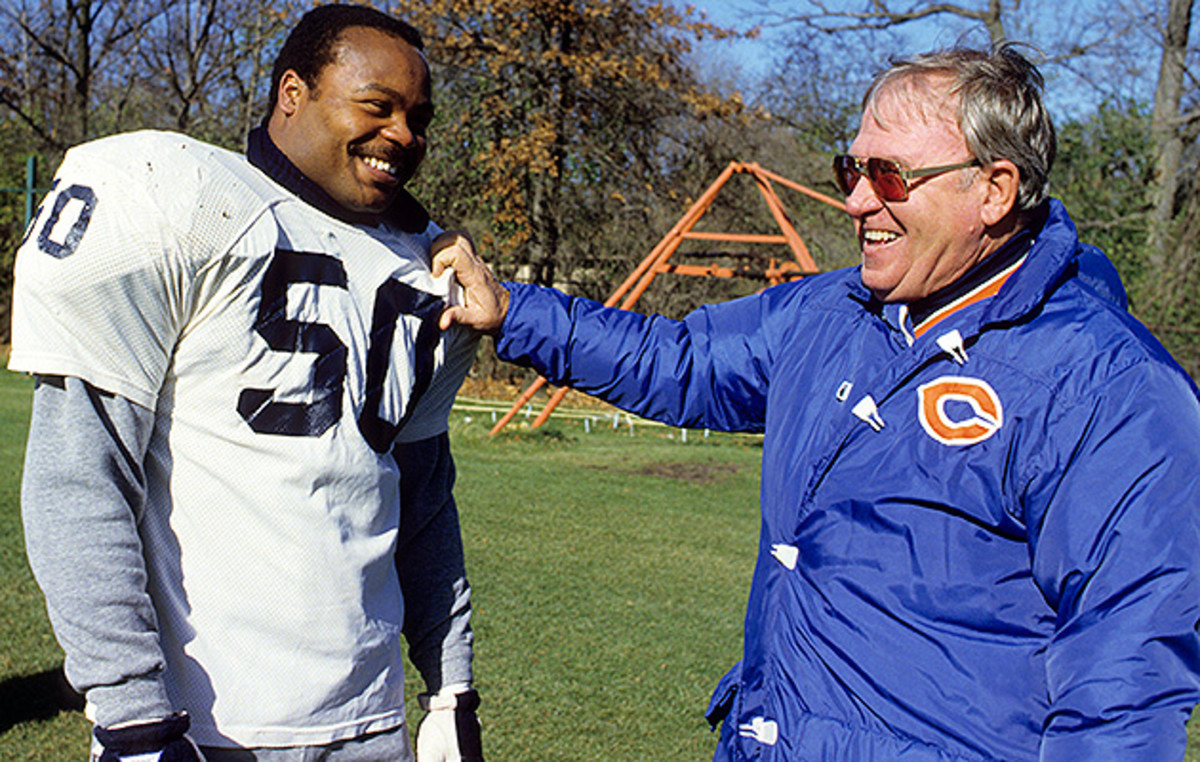
The Bears who took the field in ’85 were exquisitely suited to Ryan’s system. The inside three linemen—McMichael, Hampton and either Refrigerator Perry or Mike Hartenstine—had the brute strength to occupy the inside of the offensive line and often put pressure on passers without blitz help. Dent, an eighth-round draft pick who came into the NFL at 230 pounds, much too small for a defensive end, grew to 260 and became an edge-rushing force. The clogged middle forced teams to try to run outside, where regular linebackers Marshall, Singletary and Wilson were fast enough to pursue. Plank, who retired following the 1982 season after suffering a spinal concussion, was replaced first by Todd Bell, and then by Dave Duerson. “The whole thing started with covering the center and both guards,” says Ryan. “Nobody had really ever done it before. It was hard to run against it. And with the guys we had in the middle, and Richard Dent, it was hard to pass against it too. Not to sound arrogant, but for a while there nobody really gave us any problems.”
The great potential weakness of the 46 is that cornerbacks can often be left in one-on-one coverage. Ryan’s hope was always that the quarterback wouldn’t have time to exploit it. Or wouldn’t be able to recognize quickly enough how to exploit it. Despite its reputation as a scheme of relentless, one-dimensional pressure, the 46 is, in fact, a complex combination of fronts and blitzes. “The scheme forced people to make quick decisions,” says Fencik. “And some teams just couldn’t adjust. Buddy set up this system within the 46 where we would audible fronts and coverage based on what the offense showed. It required a lot of coordination. But very few offenses were prepared to audible two times, and once we would show something and then audible, well, it just made you very confident that you would rarely be in a bad position.” As an added benefit, the multiple fronts forced teams to eat up practice time preparing for the Bears’ 46, limiting their ability to game-plan a diverse offense.
On a much different level, Ryan connected emotionally with his players. This facet is often now muddied by episodes that would taint Ryan’s legacy later in his career. In 1989 as coach of the Eagles, Ryan was accused by the Dallas Cowboys of putting “bounties” on kicker Luis Zendejas and quarterback Troy Aikman, promising rewards to players who could knock either man out of the game, charges Ryan has always denied. Four years later, as defensive coordinator of the Houston Oilers, he was captured on national television slugging offensive coordinator Kevin Gilbride after criticizing Gilbride’s run-and-shoot offense, which Ryan felt left his defensive players on the field too often and too long.
• At 53, Refrigerator Perry is happy despite a life spiraling out of control
But in 1985 Ryan’s fire burned all to the good. He was rough on some players. “I hated him,” Singletary told The New York Times in ’85. “He was always picking on me. When I first came into camp, he referred to me as ‘the little, short, fat guy’ and always ‘Number 50.’ He never called me by my name.” (Gary Fencik, it seems, takes it a little differently: “When I see Buddy to this day, or call him up, he calls me ‘45.’ And I would be offended if he called me anything else.”) But Fencik does recall the treatment of Singletary. “The first training camp,” he says, “Mike Singletary couldn’t finish the 10-minute run, and Buddy was merciless with him for a long time after that. Buddy was a sergeant in the Korean War. You had to earn his respect.”
And most players wanted to earn that respect. “Buddy was a one-of-a-kind individual,” Fencik continues. “You did not want to fail him. There were times when I was playing for Buddy, and out on the field if something was going wrong, all I could think was that I didn’t want to disappoint my coach or my teammates. How is this going to look when they play the game film on Monday? It became a very emotional situation. Buddy created a unit mentality. We’re all in this together. And this was a very big part of the success of the Bears’ defense in that era. When you combine that with the encyclopedia of defenses that our opponents had to prepare for, it just set us up very well.”
Ryan routinely allowed his players to tweak his defensive schemes. Fencik, the defensive captain, would approach Ryan on the sideline with a message from Marshall or Dent asking for freedom to run a certain stunt. Ryan would grumble, “Who’s running this defense, anyway?” but then he would grant permission with the caveat that if something didn’t work, it would be shelved for the rest of the day.
The Bears’ defense was brilliant in 1984, leading the NFL in overall defense, rushing defense and sacks. By the time ’85 arrived, Chicago often had teams beat before the first snap.
“Say a team had first-and-10,” recalls Fencik. “They know they can’t run the ball, so they call a pass play and go to max protect, keeping both backs in and helping with a tight end. But we’re not blitzing at this point; we rush four and drop seven, and they’re looking at throwing into that with two receivers. No chance. So it’s second-and-10. Now it comes down to tendencies, and maybe we blitz and get them in third-and-long, and then all the advantage goes to Buddy.
“We had one series where we would blitz inside our own 20-yard line,” says Fencik. “But then teams would recognize that and start calling an audible if we looked like we were showing blitz, and we would back off and double both wideouts. It was just a period in time where not only did we have superior talent, but we had a superior system.”
Ryan took the 46 to Philadelphia and went 43-38-1 in five seasons before he was fired. He would have less success in Arizona, where he was head coach of the Cardinals for two seasons. As with all innovations, Ryan’s 46 forced adaptation on the league. Passing offense grew more sophisticated, finding ways to put more pressure on the vulnerable cornerbacks and the single high free safety. Yet defensive coaches continued to rely on creative pressure packages to disrupt timed pass routes, none more than one Rex Ryan in Baltimore. “I’m not the only one,” he said in the fall of 2008. “Every time you see some team moving people around to get pressure, you should think of my father. He influenced every one of them.”
• The best quotes from Buddy Ryan | NFL players pay tribute to Ryan
Florham Park, N.J. May 2009
As coach of the New York Jets, Rex Ryan has a huge office, but he fills it nonetheless. He fills it with a big body: tree-trunk legs stretching massive mesh shorts and a gargantuan torso draped in a green Jets golf shirt. But more than with his bulk, he fills the room with his personality, a self-confidence that borders on bravado, driven by a sense of having been denied too long. There is a good deal of Buddy in Rex, and Rex likes to hear that. “Dad was a hell of a football coach,” says Rex. “He knew what he was doing.”
Buddy was a hell of a football coach in Buffalo, traveling on a recruiting trip in December of 1962 when his wife, Doris, gave birth to twin boys back in Oklahoma. The news of their birth reached Buddy slowly. “He found out about it the next day,” says Doris. “Or maybe it was two days.” Rex and Rob the twins were named. They had an older brother, Jim. All three were in the stadium in Miami for Super Bowl III and again in New Orleans for Super Bowl XX. Rex and Rob would become coaches. (Jim is a lawyer.) The family now has a combined five Super Bowl rings: Buddy’s two with the Jets and Bears, Rob’s two while working as a defensive assistant under Bill Belichick with the Patriots and Rex’s with the 2000 Ravens.
Should anyone doubt the Ryan boys’ bona fides as football coaches, consider this: Both Rex and Rob played football as fourth-graders living in Toronto but were thrown off the team for hitting a player too hard. Doris marched onto the field and said, “This is a contact sport where I come from.”
Banned from football, the Ryan boys played baseball and hockey. (Rex was an all-star goalie.) In the fall of 1977 Doris sent the boys, then 14 years old, to live with Buddy, who was beginning his second season under Bud Grant with the Vikings. “It was time for them to be with their father,” says Doris (by then, she and Buddy were divorced). They lived with Buddy and Joanie for a year in Minnesota and four years in Chicago. Rex and Rob were ball boys for the Bears. Walter Payton was their best friend. They soaked up football every day. Buddy knew firsthand what coaching could do to a man’s personal life, and as Rex and Rob moved on through college, he tried to steer them away from it. But they persisted, and in the spring of ’87, while he was coach of the Eagles, Buddy traveled to Oklahoma, rented a hotel conference room and taught his sons the 46 on a paper easel with a black marker. And they gave as good as they got. “They knew plenty,” says Buddy. “So I told ’em to go get some jobs.”
• MMQB: Rex and Rob Ryan on their NFL past and future
Rex went from Eastern Kentucky to New Mexico Highlands to Morehead State—“the big time,” he says—before joining his dad and brother on the staff of the Arizona Cardinals in the fall of 1994. Both were defensive assistants. “Best ones I had,” says Buddy. “People said it was nepotism. Bulllllls---.” The Cardinals went 8–8 in the Ryans’ first year and ranked No. 3 in the NFL in defense but slipped to 4–12 and last in scoring defense in ’95. That got Buddy fired.
Rex didn’t get a single job offer from an NFL team. So he took a job as the defensive coordinator at the University of Cincinnati under coach Rick Minter. I’m gonna punish people now, Ryan thought to himself. I’m going back to the college game, and I’m gonna punish people. Early in two-a-days in the summer of 1996, Minter called for a nine-on-seven inside running game drill, in which the two defensive safeties are on the field essentially as props and not intended to tackle or be blocked. “On the first rep Rex calls for a free safety blitz up the A gap,” says Minter. “He just stones the running back. I say, ‘Rex, my gosh, it’s a nine-on-seven drill.’ Rex says, ‘Coach, we’ve got to set the tone around here.’ ”
Rex coached for two years at Cincinnati, where he built a defense that was indeed punishing. In ’98 he spent a year as defensive line coach at Oklahoma, and then, in ’99, Brian Billick hired him as a defensive assistant with the Ravens, bringing him back into the NFL. He immediately connected with players. “Coaches are mostly pains in the ass,” says Rob Burnett, who was a nine-year veteran defensive tackle when Ryan came to the Ravens in ’99. “Rex has a humanity to him that most coaches don’t have. It’s rare for guys to want to win for their coach in this league. But we would have jumped on a grenade for that guy.”
In 2002 defensive coordinator Marvin Lewis left the Ravens, and Billick promoted Mike Nolan to defensive coordinator. “I was pissed because, basically I got f---ed,” says Rex. “Brian never knew me. Maybe I never fit his image. But it was a crock of s---.” (Billick’s take: “When Marvin left, I had Mike Nolan on my staff, and I felt we needed a more veteran presence. But I knew Rex had coordinator capabilities. You don’t spend five minutes around Rex Ryan and not see his passion.”)
Three more years under Nolan. Three more years waiting for a chance. Finally, when Nolan left to become head coach of the 49ers in 2005, Ryan was promoted to defensive coordinator. For four years he would be a key figure in accelerating the defensive evolution in the NFL.
For starters Rex installed the Ryan family attitude, which, at its core, meant the intimidation of opponents, achieved primarily by hitting and hitting hard, right up to the edge of what the rules allow (and sometimes beyond). “It starts with a common mindset,” says Plank. “And without that mindset, the playbook the Ryan family has used for 30 years is irrelevant.” Then Rex went to work on his schemes.
Dick LeBeau and Dom Capers had changed the pressure paradigm with the zone blitz. Rex used many of their ideas, mixed with two cornerstone principles. One: Stop the run. “Say what you want about me,” says Ryan, “but if I want to, I’ll stop your run.” Two: Knock the quarterback on his back, for the simple reason best expressed by Rob Ryan (who in 2009 was Eric Mangini’s defensive coordinator with the Browns). “The more you hit the quarterback,” Rob says, “the better you’re going to do.”
LeBeau’s zone scheme is characterized by unpredictability within a fairly static 3–4 formation. Rex took the next step, dramatically altering the placement of players on the field. It became common to see the Ravens line up with only one player in a three-point stance and five or six other linemen and linebackers strolling around in the tackle box, waiting for the offense to call an audible before deciding where to attack from, or whether to attack at all. While his base alignment is a 3–4, Ryan’s willingness to move players around to anywhere on the field freed him to conceive almost limitless schemes.
Jim Fassell, who has coached both with and against Ryan, says, “Rex started doing things that nobody had ever done before. He would start out with seven or eight guys in the box, and then walk five of them out of the box right before the snap. He really caused a lot of consternation to offenses.”
“Rex has an immense defensive package,” says former Oakland and Tampa Bay head coach Jon Gruden. “I’ve seen him do almost everything imaginable. He was one of the first guys to major in what I call ‘designer blitzes,’ which are blitzes that are dialed up just for a particular game or a particular situation.”
Ryan’s defenses clearly dovetailed neatly with the changing profile of the modern athlete. No longer is a professional defense made up of cookie-cutter positional players. Defensive ends are faster than some running backs. Linebackers are stronger than some offensive tackles. Safeties are capable of rushing the passer from 10 yards off the line of scrimmage, bringing speed and power to the blitz from the deep third of the field. “Look at the collection of athletes we had in Baltimore,” says Adalius Thomas, who played under Ryan with the Ravens. “There were a bunch of versatile guys out there, and some of them are going to the Hall of Fame.” Since all 11 of Ryan’s defenders were capable of blitzing, he disguised his pressures by making it seem as if they might all blitz.
Thomas was among the most versatile. At 6' 2", 270 pounds, he played every position on the defense except cornerback. There were other transcendent athletes: safety Ed Reed, linebackers Ray Lewis and Terrell Suggs and interior space-eaters Tony Siragusa and Haloti Ngata. The 2006 Ravens led the NFL by allowing an average of just 12.1 points per game and held Peyton Manning’s Indianapolis Colts to just five field goals in a 15–6 playoff loss.
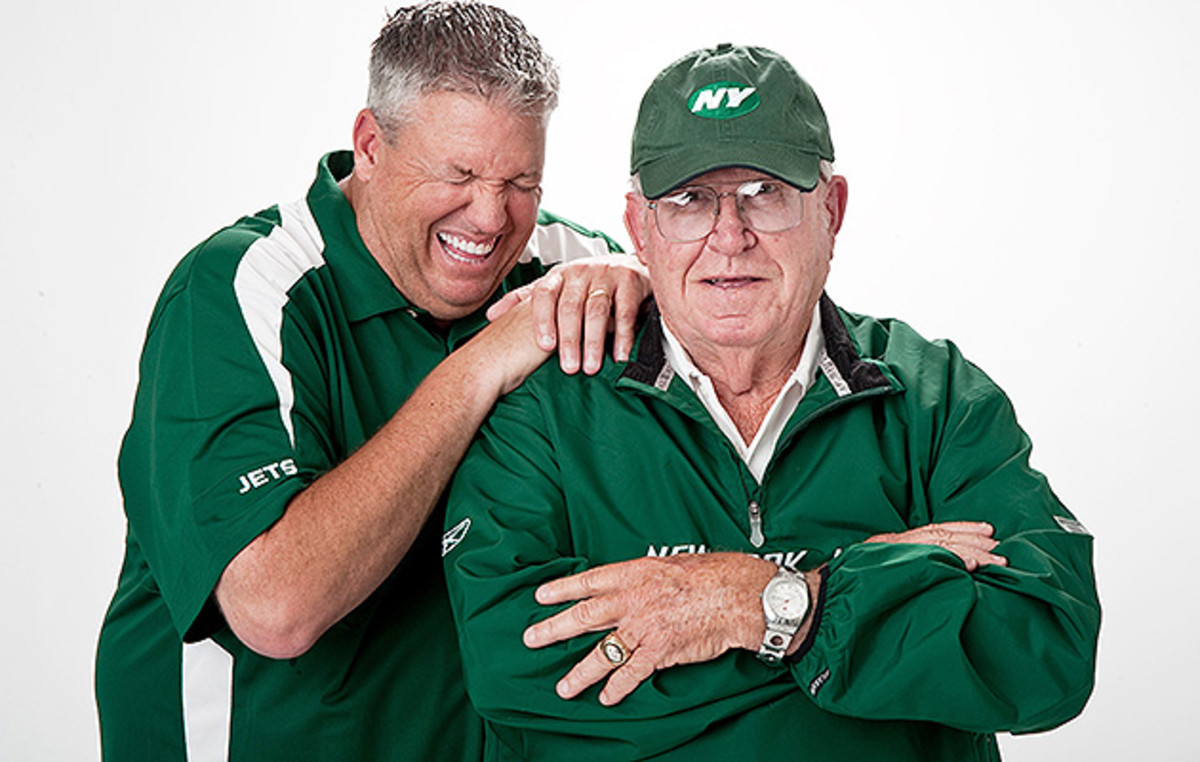
Rex Ryan’s defense has no name to put alongside his father’s 46, but it is invoked in every NFL game on every weekend. Scrambling, amorphous defensive looks have become common. Hybrid players have become standard. The blitzing of quarterbacks has never been more at a premium. That is the influence of Rex Ryan’s unnamed defense, a link in the chain between his father and the future.
